Caduet (amlodipine besylate 10 mg atorvastatin calcium trihydrate 40 mg) Dailymed
Generic: amlodipine and atorvastatin is used for the treatment of Angina Pectoris, Variant Coronary Artery Disease Hypertension Hypotension Hypercholesterolemia Hyperlipoproteinemias Lactation Liver Diseases Pregnancy Hypertriglyceridemia Liver Failure
All Imprints
amlodipine 5 mg / atorvastatin 10 mg oral tablet [caduet] - pfizer cdt 051 oval white
amlodipine besylate 2.5 mgatorvastatin calcium trihydrate 20 mg - pfizer cdt 252 round white
amlodipine besylate 10 mgatorvastatin calcium trihydrate 80 mg - pfizer cdt 108 oval blue
amlodipine besylate 5 mgatorvastatin calcium trihydrate 80 mg - pfizer cdt 058 oval white
amlodipine besylate 5 mgatorvastatin calcium trihydrate 10 mg - pfizer cdt 051 oval white
amlodipine besylate 5 mgatorvastatin calcium trihydrate 40 mg - pfizer cdt 054 oval white
amlodipine besylate 2.5 mgatorvastatin calcium trihydrate 40 mg - pfizer cdt 254 round white
amlodipine besylate 10 mgatorvastatin calcium trihydrate 20 mg - pfizer cdt 102 oval blue
amlodipine besylate 10 mgatorvastatin calcium trihydrate 10 mg - pfizer cdt 101 oval blue
amlodipine besylate 2.5 mgatorvastatin calcium trihydrate 10 mg - pfizer cdt 251 round white
amlodipine besylate 5 mgatorvastatin calcium trihydrate 20 mg - pfizer cdt 052 oval white
amlodipine besylate 10 mgatorvastatin calcium trihydrate 40 mg - pfizer cdt 104 oval blue
Go PRO for all pill images
1 Indications And Usage
CADUET (amlodipine and atorvastatin) is indicated in patients for whom treatment with both amlodipine and atorvastatin is appropriate.
CADUET is a combination of amlodipine besylate, a calcium channel blocker, and atorvastatin calcium, a HMG CoA-reductase inhibitor, indicated in patients for whom treatment with both amlodipine and atorvastatin is appropriate.
Amlodipine is indicated for the treatment of hypertension, to lower blood pressure (1.1 ). Lowering blood pressure reduces the risk of fatal and nonfatal cardiovascular events, primarily strokes and myocardial infarctions.
Amlodipine is indicated for the treatment of Coronary Artery Disease (1.2 ).
Atorvastatin is indicated as an adjunct therapy to diet for prevention of cardiovascular disease (1.3 ) and hyperlipidemia (1.4 ).
Amlodipine
1.1Hypertension
Amlodipine is indicated for the treatment of hypertension, to lower blood pressure. Lowering blood pressure reduces the risk of fatal and nonfatal cardiovascular events, primarily strokes and myocardial infarctions. These benefits have been seen in controlled trials of antihypertensive drugs from a wide variety of pharmacologic classes including amlodipine.
Control of high blood pressure should be part of comprehensive cardiovascular risk management, including, as appropriate, lipid control, diabetes management, antithrombotic therapy, smoking cessation, exercise, and limited sodium intake. Many patients will require more than one drug to achieve blood pressure goals. For specific advice on goals and management, see published guidelines, such as those of the National High Blood Pressure Education Program's Joint National Committee on Prevention, Detection, Evaluation, and Treatment of High Blood Pressure (JNC).
Numerous antihypertensive drugs, from a variety of pharmacologic classes and with different mechanisms of action, have been shown in randomized controlled trials to reduce cardiovascular morbidity and mortality, and it can be concluded that it is blood pressure reduction, and not some other pharmacologic property of the drugs, that is largely responsible for those benefits. The largest and most consistent cardiovascular outcome benefit has been a reduction in the risk of stroke, but reductions in myocardial infarction and cardiovascular mortality also have been seen regularly.
Elevated systolic or diastolic pressure causes increased cardiovascular risk, and the absolute risk increase per mmHg is greater at higher blood pressures, so that even modest reductions of severe hypertension can provide substantial benefit. Relative risk reduction from blood pressure reduction is similar across populations with varying absolute risk, so the absolute benefit is greater in patients who are at higher risk independent of their hypertension (for example, patients with diabetes or hyperlipidemia), and such patients would be expected to benefit from more aggressive treatment to a lower blood pressure goal.
Some antihypertensive drugs have smaller blood pressure effects (as monotherapy) in black patients, and many antihypertensive drugs have additional approved indications and effects (e.g., on angina, heart failure, or diabetic kidney disease). These considerations may guide selection of therapy.
Amlodipine may be used alone or in combination with other antihypertensive agents.
1.2Coronary Artery Disease (CAD)
Chronic Stable Angina
Amlodipine is indicated for the symptomatic treatment of chronic stable angina. Amlodipine may be used alone or in combination with other antianginal agents.
Vasospastic Angina (Prinzmetal's or Variant Angina)
Amlodipine is indicated for the treatment of confirmed or suspected vasospastic angina. Amlodipine may be used as monotherapy or in combination with other antianginal agents.
Angiographically Documented CAD
In patients with recently documented CAD by angiography and without heart failure or an ejection fraction < 40%, amlodipine is indicated to reduce the risk of hospitalization for angina and to reduce the risk of a coronary revascularization procedure.
Atorvastatin
Therapy with HMG CoA-reductase inhibitors (lipid-altering agents) should be only one component of multiple risk factor intervention in individuals at significantly increased risk for atherosclerotic vascular disease from hypercholesterolemia. Drug therapy is recommended as an adjunct to diet when the response to a diet restricted in saturated fat and cholesterol and other nonpharmacologic measures alone has been inadequate. In patients with coronary heart disease (CHD) or multiple risk factors for CHD, atorvastatin can be started simultaneously with diet restriction.
1.3Prevention of Cardiovascular Disease (CVD) in Adults
In adult patients without clinically evident coronary heart disease, but with multiple risk factors for coronary heart disease such as age, smoking, hypertension, low high-density lipoprotein cholesterol (HDL-C), or a family history of early coronary heart disease, atorvastatin is indicated to:
• Reduce the risk of myocardial infarction (MI)• Reduce the risk of stroke• Reduce the risk for revascularization procedures and angina
In adult patients with type 2 diabetes, and without clinically evident coronary heart disease, but with multiple risk factors for coronary heart disease such as retinopathy, albuminuria, smoking, or hypertension, atorvastatin is indicated to:
• Reduce the risk of myocardial infarction• Reduce the risk of stroke
In adult patients with clinically evident coronary heart disease, atorvastatin is indicated to:
• Reduce the risk of non-fatal myocardial infarction• Reduce the risk of fatal and non-fatal stroke• Reduce the risk for revascularization procedures• Reduce the risk of hospitalization for congestive heart failure (CHF)• Reduce the risk of angina1.4Hyperlipidemia
Atorvastatin is indicated:
• As an adjunct to diet to reduce elevated total cholesterol (total-C), low-density lipoprotein cholesterol (LDL-C), apolipoprotein B (apo B), and triglycerides (TG) levels and to increase HDL-C in adult patients with primary hypercholesterolemia (heterozygous familial and nonfamilial) and mixed dyslipidemia (Fredrickson Types IIa and IIb)• As an adjunct to diet for the treatment of adult patients with elevated serum TG levels (Fredrickson Type IV);• For the treatment of adult patients with primary dysbetalipoproteinemia (Fredrickson Type III) who do not respond adequately to diet• To reduce total-C and LDL-C in patients with homozygous familial hypercholesterolemia (HoFH) as an adjunct to other lipid-lowering treatments (e.g., LDL apheresis) or if such treatments are unavailable• As an adjunct to diet to reduce total-C, LDL-C, and apo B levels in pediatric patients, 10 years to 17 years of age, with heterozygous familial hypercholesterolemia (HeFH) if after an adequate trial of diet therapy the following findings are present:
1. LDL-C remains ≥ 190 mg/dL or2. LDL-C remains ≥ 160 mg/dL and:
â–ª there is a positive family history of premature CVD orâ–ª two or more other CVD risk factors are present in the pediatric patient1.5Limitations of Use
Atorvastatin has not been studied in conditions where the major lipoprotein abnormality is elevation of chylomicrons (Fredrickson Types I and V).
2 Dosage And Administration
Usual starting dose (mg daily) Maximum dose (mg daily)
Amlodipine
5Start small adults or children, fragile, or elderly patients, or patients with hepatic insufficiency on 2.5 mg once daily ( 2 )
10
Atorvastatin
10–20Start patients requiring large LDL-C reduction (> 45%) at 40 mg once daily ( 2 )
80
CADUET
Dosage of CADUET must be individualized on the basis of both effectiveness and tolerance for each individual component in the treatment of hypertension/angina and hyperlipidemia. Select doses of amlodipine and atorvastatin independently.
CADUET may be substituted for its individually titrated components. Patients may be given the equivalent dose of CADUET or a dose of CADUET with increased amounts of amlodipine, atorvastatin, or both for additional antianginal effects, blood pressure lowering, or lipid-lowering effect.
CADUET may be used to provide additional therapy for patients already on one of its components. CADUET may be used to initiate treatment in patients with hyperlipidemia and either hypertension or angina.
Amlodipine
The usual initial antihypertensive oral dose of amlodipine is 5 mg once daily, and the maximum dose is 10 mg once daily.
Pediatric (age > 6 years), small adult, fragile, or elderly patients, or patients with hepatic insufficiency may be started on 2.5 mg once daily and this dose may be used when adding amlodipine to other antihypertensive therapy.
Adjust dosage according to blood pressure goals. In general, wait 7 to 14 days between titration steps. Titration may proceed more rapidly, however, if clinically warranted, provided the patient is assessed frequently.
Angina: The recommended dose of amlodipine for chronic stable or vasospastic angina is 5–10 mg, with the lower dose suggested in the elderly and in patients with hepatic insufficiency. Most patients will require 10 mg for adequate effect.
Coronary Artery Disease: The recommended dose range of amlodipine for patients with CAD is 5–10 mg once daily. In clinical studies, the majority of patients required 10 mg [see Clinical Studies (14.4)].
Pediatrics: The effective antihypertensive oral dose of amlodipine in pediatric patients ages 6–17 years is 2.5 mg to 5 mg once daily. Doses in excess of 5 mg daily have not been studied in pediatric patients [see Clinical Pharmacology (12.3), Clinical Studies (14.1)].
Atorvastatin (Hyperlipidemia)
Hyperlipidemia and Mixed Dyslipidemia: The recommended starting dose of atorvastatin is 10 or 20 mg once daily. Patients who require a large reduction in LDL-C (more than 45%) may be started at 40 mg once daily. The dosage range of atorvastatin is 10 to 80 mg once daily. Atorvastatin can be administered as a single dose at any time of the day, with or without food. The starting dose and maintenance doses of atorvastatin should be individualized according to patient characteristics such as goal of therapy and response. After initiation and/or upon titration of atorvastatin, lipid levels should be analyzed within 2 to 4 weeks and dosage adjusted accordingly.
Homozygous Familial Hypercholesterolemia: The dosage range of atorvastatin in patients with HoFH is 10 to 80 mg daily. Atorvastatin should be used as an adjunct to other lipid-lowering treatments (e.g., LDL apheresis) in these patients or if such treatments are unavailable.
Concomitant Lipid-Lowering Therapy: Atorvastatin may be used with bile acid resins. Monitor for signs of myopathy in patients receiving the combination of HMG-CoA reductase inhibitors (statins) and fibrates [see Warnings and Precautions (5.1), Drug Interactions (7)].
Patients with Renal Impairment: Renal disease does not affect the plasma concentrations nor LDL-C reduction of atorvastatin; thus, dosage adjustment in patients with renal dysfunction is not necessary [see Warnings and Precautions (5.1), Clinical Pharmacology (12.3)].
Use with Cyclosporine, Clarithromycin, Itraconazole, Letermovir, or Certain Protease Inhibitors: In patients taking cyclosporine or the human immunodeficiency virus (HIV) protease inhibitor tipranavir plus ritonavir or the hepatitis C virus (HCV) protease inhibitor glecaprevir plus pibrentasvir, or letermovir when co-administered with cyclosporine, therapy with atorvastatin should be avoided. In patients with HIV taking lopinavir plus ritonavir, use the lowest dose necessary of atorvastatin. In patients taking clarithromycin, itraconazole, elbasvir plus grazoprevir, or in patients with HIV taking a combination of saquinavir plus ritonavir, darunavir plus ritonavir, fosamprenavir, fosamprenavir plus ritonavir, or letermovir therapy with atorvastatin should be limited to 20 mg, and appropriate clinical assessment is recommended to ensure that the lowest dose necessary of atorvastatin is used. In patients taking the HIV protease inhibitor nelfinavir therapy with atorvastatin should be limited to 40 mg [see Warnings and Precautions (5.1), Drug Interactions (7.3)].
Heterozygous Familial Hypercholesterolemia in Pediatric Patients (10 Years to 17 Years of Age): The recommended starting dose of atorvastatin is 10 mg/day; the usual dose range is 10 to 20 mg orally once daily [see Clinical Studies (14.11)]. Doses should be individualized according to the recommended goal of therapy [see Indications and Usage (1.4) and Clinical Pharmacology (12)]. Adjustments should be made at intervals of 4 weeks or more.
3 Dosage Forms And Strengths
CADUET tablets are formulated for oral administration in the following strength combinations:
Table 1 Atorvastatin (mg) 10 20 40 80
Amlodipine (mg)
5
X
X
X
X
10
X
X
X
X
Combinations of atorvastatin with 5 mg amlodipine are film-coated white and combinations of atorvastatin with 10 mg amlodipine are film-coated blue.
Tablets contain amlodipine besylate equivalent to amlodipine 5 or 10 mg and atorvastatin calcium equivalent to atorvastatin 10, 20, 40, or 80 mg (3 ).
4 Contraindications
• Active Liver Disease, Which May Include Unexplained Persistent Elevations in Hepatic Transaminase Levels• Pregnancy [see Use in Specific Populations (8.1)]• Lactation [see Use in Specific Populations (8.2)]
• Active liver disease (4 )• Pregnancy (4 )• Lactation (4 )
5 Warnings And Precautions
• Myopathy and Rhabdomyolysis: Advise patients to promptly report to their physician unexplained and/or persistent muscle pain, tenderness, or weakness. CADUET therapy should be discontinued if myopathy is diagnosed or suspected (2 ,5.1 ,8.5 ).• Immune-Mediated Necrotizing Myopathy (IMNM): Monitor for myalgia and treat (5.2 ).• Hepatic Transaminitis: Monitor liver enzymes before and during treatment (5.3 ).• Symptomatic hypotension is possible, particularly in patients with severe aortic stenosis. However, acute hypotension is unlikely (5.5 ).• Angina or myocardial infarction may occur with initiation or dose increase (5.4 ).5.1Myopathy and Rhabdomyolysis
CADUET may cause myopathy (muscle pain, tenderness, or weakness with creatine kinase (CK) above ten times the upper limit of normal) and rhabdomyolysis (with or without acute renal failure secondary to myoglobinuria). Rare fatalities have occurred as a result of rhabdomyolysis with statin use, including CADUET.
Risk Factors for Myopathy
Risk factors for myopathy include age 65 years or greater, uncontrolled hypothyroidism, renal impairment, concomitant use with certain other drugs, and higher CADUET dosage [see Drug Interactions (7.3)].
Steps to Prevent or Reduce the Risk of Myopathy and Rhabdomyolysis
CADUET exposure may be increased by drug interactions due to inhibition of cytochrome P450 enzyme 3A4 (CYP3A4) and/or transporters (e.g., breast cancer resistant protein [BCRP], organic anion-transporting polypeptide [OATP1B1/OATP1B3] and P-glycoprotein [P-gp]), resulting in an increased risk of myopathy and rhabdomyolysis. Concomitant use of cyclosporine, gemfibrozil, tipranavir plus ritonavir or glecaprevir plus pibrentasvir with CADUET is not recommended. CADUET dosage modifications are recommended for patients taking certain anti-viral, azole antifungals, or macrolide antibiotic medications [see Dosage and Administration (2)]. Cases of myopathy/rhabdomyolysis have been reported with atorvastatin co-administered with lipid modifying doses (>1 gram/day) of niacin, fibrates, colchicine, and ledipasvir plus sofosbuvir. Consider if the benefit of use of these products outweighs the increased risk of myopathy and rhabdomyolysis [see Drug Interactions (7.3)].
Concomitant intake of large quantities, more than 1.2 liters daily, of grapefruit juice is not recommended in patients taking CADUET [see Drug Interactions (7.3)].
Discontinue CADUET if markedly elevated CK levels occur or myopathy is diagnosed or suspected. Muscle symptoms and CK increases may resolve if CADUET is discontinued. Temporarily discontinue CADUET in patients experiencing an acute or serious condition at high risk of developing renal failure secondary to rhabdomyolysis (e.g., sepsis; shock; severe hypovolemia; major surgery; trauma; severe metabolic, endocrine, or electrolyte disorders; or uncontrolled epilepsy).
Inform patients of the risk of myopathy and rhabdomyolysis when starting or increasing the CADUET dosage. Instruct patients to promptly report any unexplained muscle pain, tenderness or weakness, particularly if accompanied by malaise or fever.
5.2Immune-Mediated Necrotizing Myopathy
There have been rare reports of immune-mediated necrotizing myopathy (IMNM), an autoimmune myopathy, associated with statin use. IMNM is characterized by: proximal muscle weakness and elevated serum creatine kinase, which persist despite discontinuation of statin treatment; positive anti-HMG CoA reductase antibody; muscle biopsy showing necrotizing myopathy; and improvement with immunosuppressive agents. Additional neuromuscular and serologic testing may be necessary. Treatment with immunosuppressive agents may be required. Consider risk of IMNM carefully prior to initiation of a different statin. If therapy is initiated with a different statin, monitor for signs and symptoms of IMNM.
5.3Liver Dysfunction
Statins, like atorvastatin, and some other lipid-lowering therapies, have been associated with biochemical abnormalities of liver function. Persistent elevations (> 3 times the upper limit of normal [ULN] occurring on 2 or more occasions) in serum transaminases occurred in 0.7% of patients who received atorvastatin in clinical trials. The incidence of these abnormalities was 0.2%, 0.2%, 0.6%, and 2.3% for 10, 20, 40, and 80 mg, respectively.
One patient in clinical trials with atorvastatin developed jaundice. Increases in liver function tests (LFT) in other patients were not associated with jaundice or other clinical signs or symptoms. Upon dose reduction, drug interruption, or discontinuation, transaminase levels returned to or near pretreatment levels without sequelae. Eighteen of 30 patients with persistent LFT elevations continued treatment with a reduced dose of atorvastatin.
It is recommended that liver enzyme tests be obtained prior to initiating therapy with atorvastatin and repeated as clinically indicated. There have been rare postmarketing reports of fatal and non-fatal hepatic failure in patients taking statins, including atorvastatin. If serious liver injury with clinical symptoms and/or hyperbilirubinemia or jaundice occurs during treatment with CADUET, promptly interrupt therapy. If an alternate etiology is not found, do not restart CADUET.
Active liver disease or unexplained persistent transaminase elevations are contraindications to the use of CADUET [see Contraindications (4)].
5.4Increased Angina and Myocardial Infarction
Worsening angina and acute myocardial infarction can develop after starting or increasing the dose of amlodipine, particularly in patients with severe obstructive coronary artery disease.
5.5Hypotension
Symptomatic hypotension is possible with use of amlodipine, particularly in patients with severe aortic stenosis. Because of the gradual onset of action, acute hypotension is unlikely.
5.6Endocrine Function
Increases in HbA1c and fasting serum glucose levels have been reported with HMG-CoA reductase inhibitors, including atorvastatin.
Statins interfere with cholesterol synthesis and theoretically might blunt adrenal and/or gonadal steroid production. Clinical studies have shown that atorvastatin does not reduce basal plasma cortisol concentration or impair adrenal reserve. The effects of statins on male fertility have not been studied in adequate numbers of patients. The effects, if any, on the pituitary-gonadal axis in premenopausal women are unknown. Avoid a statin with drugs that may decrease the levels or activity of endogenous steroid hormones such as ketoconazole, spironolactone, and cimetidine.
5.7CNS Toxicity
Brain hemorrhage was seen in a female dog treated with atorvastatin for 3 months at 120 mg/kg/day. Brain hemorrhage and optic nerve vacuolation were seen in another female dog that was sacrificed in moribund condition after 11 weeks of escalating doses up to 280 mg/kg/day. The 120 mg/kg dose resulted in a systemic exposure approximately 16 times the human plasma area-under-the-curve (AUC, 0–24 hours) based on the maximum human dose of 80 mg/day. A single tonic convulsion was seen in each of 2 male dogs (one treated at 10 mg/kg/day and one at 120 mg/kg/day) in a 2-year study. No CNS lesions have been observed in mice after chronic treatment for up to 2 years at doses up to 400 mg/kg/day or in rats at doses up to 100 mg/kg/day. These doses were 6 to 11 times (mouse) and 8 to 16 times (rat) the human AUC (0–24) based on the maximum recommended human dose (MRHD) of 80 mg/day.
CNS vascular lesions, characterized by perivascular hemorrhages, edema, and mononuclear cell infiltration of perivascular spaces, have been observed in dogs treated with other statins. A chemically similar drug in this class produced optic nerve degeneration (Wallerian degeneration of retinogeniculate fibers) in clinically normal dogs in a dose-dependent fashion at a dose that produced plasma drug levels about 30 times higher than the mean drug level in humans taking the highest recommended dose.
5.8Hemorrhagic Stroke
In a post-hoc analysis of the Stroke Prevention by Aggressive Reduction in Cholesterol Levels (SPARCL) study where atorvastatin 80 mg vs. placebo was administered in 4,731 subjects without CHD who had a stroke or TIA within the preceding 6 months, a higher incidence of hemorrhagic stroke was seen in the atorvastatin 80 mg group compared to placebo (55, 2.3% atorvastatin vs. 33, 1.4% placebo; HR: 1.68, 95% CI: 1.09, 2.59; p=0.0168). The incidence of fatal hemorrhagic stroke was similar across treatment groups (17 vs. 18 for the atorvastatin and placebo groups, respectively). The incidence of non-fatal hemorrhagic stroke was significantly higher in the atorvastatin group (38, 1.6%) as compared to the placebo group (16, 0.7%). Some baseline characteristics, including hemorrhagic and lacunar stroke on study entry, were associated with a higher incidence of hemorrhagic stroke in the atorvastatin group [see Adverse Reactions (6.1)].
6 Adverse Reactions
The following serious adverse reactions are discussed in greater detail in other sections of the label:
• Myopathy and Rhabdomyolysis [see Warnings and Precautions (5.1)]• Liver enzyme abnormalities [see Warnings and Precautions (5.3)]
Most common adverse reaction (3% greater than placebo) to amlodipine is edema (6.1 ).
Most common adverse reactions leading to atorvastatin discontinuation were myalgia and diarrhea (6.1 ).
To report SUSPECTED ADVERSE REACTIONS, contact Pfizer Inc. at 1-800-438-1985 or FDA at 1-800-FDA-1088 orwww.fda.gov/medwatch
6.1Clinical Trials Experience
Because clinical trials are conducted under widely varying conditions, adverse reaction rates observed in the clinical trials of a drug cannot be directly compared to rates in the clinical trials of another drug and may not reflect the rates observed in practice.
CADUET
CADUET (amlodipine/atorvastatin) has been evaluated for safety in 1,092 patients in double-blind placebo-controlled studies treated for co-morbid hypertension and dyslipidemia. In general, treatment with CADUET was well tolerated. For the most part, adverse reactions have been mild or moderate in severity. In clinical trials with CADUET, no adverse reactions peculiar to this combination have been observed. Adverse reactions are similar in terms of nature, severity, and frequency to those reported previously with amlodipine and atorvastatin.
The following information is based on the clinical experience with amlodipine and atorvastatin.
Amlodipine
Amlodipine has been evaluated for safety in more than 11,000 patients in U.S. and foreign clinical trials. In general, treatment with amlodipine was well tolerated at doses up to 10 mg daily. Most adverse reactions reported during therapy with amlodipine were of mild or moderate severity. In controlled clinical trials directly comparing amlodipine (N=1,730) at doses up to 10 mg to placebo (N=1,250), discontinuation of amlodipine because of adverse reactions was required in only about 1.5% of patients and was not significantly different from placebo (about 1%). The most commonly reported side effects more frequent than placebo are dizziness and edema. The incidence (%) of side effects that occurred in a dose-related manner are as follows:
Amlodipine 2.5 mg 5 mg 10 mg Placebo N=275 N=296 N=268 N=520
Â
Edema
1.8
3.0
10.8
0.6
Dizziness
1.1
3.4
3.4
1.5
Flushing
0.7
1.4
2.6
0.0
Palpitations
0.7
1.4
4.5
0.6
Other adverse reactions that were not clearly dose related but were reported at an incidence greater than 1.0% in placebo-controlled clinical trials include the following:
Amlodipine (%) Placebo (%) (N=1730) (N=1250)
Â
Fatigue
4.5
2.8
Nausea
2.9
1.9
Abdominal Pain
1.6
0.3
Somnolence
1.4
0.6
Edema, flushing, palpitations, and somnolence appear to be more common in women than in men.
The following events occurred in < 1% but > 0.1% of patients treated with amlodipine in controlled clinical trials or under conditions of open trials or marketing experience where a causal relationship is uncertain; they are uled to alert the physician to a possible relationship:
Cardiovascular: arrhythmia (including ventricular tachycardia and atrial fibrillation), bradycardia, chest pain, peripheral ischemia, syncope, tachycardia, vasculitis.
Central and Peripheral Nervous System: hypoesthesia, neuropathy peripheral, paresthesia, tremor, vertigo.
Gastrointestinal: anorexia, constipation, dysphagia, diarrhea, flatulence, pancreatitis, vomiting, gingival hyperplasia.
General: allergic reaction, asthenia,These events occurred in less than 1% in placebo-controlled trials, but the incidence of these side effects was between 1% and 2% in all multiple dose studies. back pain, hot flushes, malaise, pain, rigors, weight gain, weight decrease.
Musculoskeletal System: arthralgia, arthrosis, muscle cramps,myalgia.
Psychiatric: sexual dysfunction (maleand female), insomnia, nervousness, depression, abnormal dreams, anxiety, depersonalization.
Respiratory System: dyspnea,epistaxis.
Skin and Appendages: angioedema, erythema multiforme, pruritus,rash, rash erythematous, rash maculopapular.
Special Senses: abnormal vision, conjunctivitis, diplopia, eye pain, tinnitus.
Urinary System: micturition frequency, micturition disorder, nocturia.
Autonomic Nervous System: dry mouth, sweating increased.
Metabolic and Nutritional: hyperglycemia, thirst.
Hemopoietic: leukopenia, purpura, thrombocytopenia.
Amlodipine therapy has not been associated with clinically significant changes in routine laboratory tests. No clinically relevant changes were noted in serum potassium, serum glucose, total TG, TC, HDL-C, uric acid, blood urea nitrogen, or creatinine.
Atorvastatin
In the atorvastatin placebo-controlled clinical trial database of 16,066 patients (8,755 atorvastatin vs. 7,311 placebo; age range 10–93 years, 39% women, 91% Caucasians, 3% Blacks, 2% Asians, 4% other) with a median treatment duration of 53 weeks, 9.7% of patients on atorvastatin and 9.5% of the patients on placebo discontinued because of adverse reactions regardless of causality. The five most common adverse reactions in patients treated with atorvastatin that led to treatment discontinuation and occurred at a rate greater than placebo were: myalgia (0.7%), diarrhea (0.5%), nausea (0.4%), alanine aminotransferase increase (0.4%), and hepatic enzyme increase (0.4%).
The most commonly reported adverse reactions (incidence ≥ 2% and greater than placebo) regardless of causality, in patients treated with atorvastatin in placebo-controlled trials (n=8,755) were: nasopharyngitis (8.3%), arthralgia (6.9%), diarrhea (6.8%), pain in extremity (6.0%), and urinary tract infection (5.7%).
Table 2 summarizes the frequency of clinical adverse reactions, regardless of causality, reported in ≥ 2% and at a rate greater than placebo in patients treated with atorvastatin (n=8,755), from seventeen placebo-controlled trials.
Table 2. Clinical Adverse Reactions Occurring in ≥ 2% in Patients Treated with Any Dose of Atorvastatin and at an Incidence Greater than Placebo Regardless of Causality (% of Patients) Adverse Reaction Adverse Reaction ≥ 2% in any dose greater than placebo. Any dose N=8755 10 mg N=3908 20 mg N=188 40 mg N=604 80 mg N=4055 Placebo N=7311
Nasopharyngitis
8.3
12.9
5.3
7.0
4.2
8.2
Arthralgia
6.9
8.9
11.7
10.6
4.3
6.5
Diarrhea
6.8
7.3
6.4
14.1
5.2
6.3
Pain in extremity
6.0
8.5
3.7
9.3
3.1
5.9
Urinary tract infection
5.7
6.9
6.4
8.0
4.1
5.6
Dyspepsia
4.7
5.9
3.2
6.0
3.3
4.3
Nausea
4.0
3.7
3.7
7.1
3.8
3.5
Musculoskeletal pain
3.8
5.2
3.2
5.1
2.3
3.6
Muscle spasms
3.6
4.6
4.8
5.1
2.4
3.0
Myalgia
3.5
3.6
5.9
8.4
2.7
3.1
Insomnia
3.0
2.8
1.1
5.3
2.8
2.9
Pharyngolaryngeal pain
2.3
3.9
1.6
2.8
0.7
2.1
Other adverse reactions reported in placebo-controlled studies include:
Body as a whole: malaise, pyrexia; Digestive system: abdominal discomfort, eructation, flatulence, hepatitis, cholestasis; Musculoskeletal system: musculoskeletal pain, muscle fatigue, neck pain, joint swelling; Metabolic and nutritional system: transaminases increase, liver function test abnormal, blood alkaline phosphatase increase, creatine phosphokinase increase, hyperglycemia; Nervous system: nightmare; Respiratory system: epistaxis; Skin and appendages: urticaria; Special senses: vision blurred, tinnitus; Urogenital system: white blood cells urine positive.
Treating to New Targets Study (TNT)
In TNT [see Clinical Studies (14.6)] involving 10,001 subjects (age range 29–78 years, 19% women; 94.1% Caucasians, 2.9% Blacks, 1.0% Asians, 2.0% other) with clinically evident CHD treated with atorvastatin 10 mg daily (n=5,006) or atorvastatin 80 mg daily (n=4,995), serious adverse reactions and discontinuations because of adverse reactions increased with dose. Persistent transaminase elevations (≥ 3 × ULN twice within 4–10 days) occurred in 62 (1.3%) individuals with atorvastatin 80 mg and in nine (0.2%) individuals with atorvastatin 10 mg. Elevations of CK (≥ 10 × ULN) were low overall, but were higher in the high-dose atorvastatin treatment group (13, 0.3%) compared to the low-dose atorvastatin group (6, 0.1%).
Stroke Prevention by Aggressive Reduction in Cholesterol Levels (SPARCL)
In SPARCL involving 4,731 subjects (age range 21–92 years, 40% women; 93.3% Caucasians, 3.0% Blacks, 0.6% Asians, 3.1% other) without clinically evident CHD but with a stroke or transient ischemic attack (TIA) within the previous 6 months treated with atorvastatin 80 mg (n=2,365) or placebo (n=2,366) for a median follow-up of 4.9 years, there was a higher incidence of persistent hepatic transaminase elevations (≥ 3 × ULN twice within 4–10 days) in the atorvastatin group (0.9%) compared to placebo (0.1%). Elevations of CK (>10 × ULN) were rare, but were higher in the atorvastatin group (0.1%) compared to placebo (0.0%). Diabetes was reported as an adverse reaction in 144 subjects (6.1%) in the atorvastatin group and 89 subjects (3.8%) in the placebo group [see Warnings and Precautions (5.6)].
In a post-hoc analysis, atorvastatin 80 mg reduced the incidence of ischemic stroke (218/2365, 9.2% vs. 274/2366, 11.6%) and increased the incidence of hemorrhagic stroke (55/2365, 2.3% vs. 33/2366, 1.4%) compared to placebo. The incidence of fatal hemorrhagic stroke was similar between groups (17 atorvastatin vs. 18 placebo). The incidence of non-fatal hemorrhagic strokes was significantly greater in the atorvastatin group (38 non-fatal hemorrhagic strokes) as compared to the placebo group (16 non-fatal hemorrhagic strokes). Subjects who entered the study with a hemorrhagic stroke appeared to be at increased risk for hemorrhagic stroke [7 (16%) atorvastatin vs. 2 (4%) placebo].
There were no significant differences between the treatment groups for all-cause mortality: 216 (9.1%) in the atorvastatin 80 mg/day group vs. 211 (8.9%) in the placebo group. The proportions of subjects who experienced cardiovascular death were numerically smaller in the atorvastatin 80 mg group (3.3%) than in the placebo group (4.1%). The proportions of subjects who experienced non-cardiovascular death were numerically larger in the atorvastatin 80 mg group (5.0%) than in the placebo group (4.0%).
Adverse Reactions from Clinical Studies of Atorvastatin in Pediatric Patients
In a 26-week controlled study in boys and postmenarchal girls with HeFH (ages 10 years to 17 years) (n=140, 31% female; 92% Caucasians, 1.6% Blacks, 1.6% Asians, 4.8% Other), the safety and tolerability profile of atorvastatin 10 to 20 mg daily, as an adjunct to diet to reduce TC, LDL-C, and apo B levels, was generally similar to that of placebo [see Use in Special Populations (8.4) and Clinical Studies (14.11)].
6.2Postmarketing Experience
The following adverse reactions have been identified during post-approval of amlodipine and atorvastatin. Because these reactions are reported voluntarily from a population of uncertain size, it is not always possible to reliably estimate their frequency or establish a causal relationship to drug exposure.
Amlodipine
The following postmarketing event has been reported infrequently where a causal relationship is uncertain: gynecomastia. In postmarketing experience, jaundice and hepatic enzyme elevations (mostly consistent with cholestasis or hepatitis), in some cases severe enough to require hospitalization, have been reported in association with use of amlodipine.
Postmarketing reporting has also revealed a possible association between extrapyramidal disorder and amlodipine.
Amlodipine has been used safely in patients with chronic obstructive pulmonary disease, well-compensated congestive heart failure, coronary artery disease, peripheral vascular disease, diabetes mellitus, and abnormal lipid profiles.
Atorvastatin
Adverse reactions associated with atorvastatin therapy reported since market introduction that are not uled above, regardless of causality assessment, include the following: anaphylaxis, angioneurotic edema, bullous rashes (including erythema multiforme, Stevens-Johnson syndrome, and toxic epidermal necrolysis), rhabdomyolysis, myositis, fatigue, tendon rupture, fatal and non-fatal hepatic failure, dizziness, depression, peripheral neuropathy, pancreatitis and interstitial lung disease.
There have been rare reports of immune-mediated necrotizing myopathy associated with statin use [see Warnings and Precautions (5.2)].
There have been rare postmarketing reports of cognitive impairment (e.g., memory loss, forgetfulness, amnesia, memory impairment, confusion) associated with statin use. These cognitive issues have been reported for all statins. The reports are generally nonserious, and reversible upon statin discontinuation, with variable times to symptom onset (1 day to years) and symptom resolution (median of 3 weeks).
7 Drug Interactions
Data from a drug-drug interaction study involving 10 mg of amlodipine and 80 mg of atorvastatin in healthy subjects indicate that the pharmacokinetics of amlodipine are not altered when the drugs are co-administered. The effect of amlodipine on the pharmacokinetics of atorvastatin showed no effect on the Cmax: 91% (90% confidence interval: 80 to 103%), but the AUC of atorvastatin increased by 18% (90% confidence interval: 109 to 127%) in the presence of amlodipine, which is not clinically meaningful.
No drug interaction studies have been conducted with CADUET and other drugs, although studies have been conducted in the individual amlodipine and atorvastatin components, as described below:
Increased Risk of Myopathy and Rhabdomyolysis ( 2 ,5.1 ,7.3 ,12.3 )
Cyclosporine, tipranavir plus ritonavir, glecaprevir plus pibrentasvir
Avoid atorvastatin
Clarithromycin, itraconazole, saquinavir plus ritonavir, darunavir plus ritonavir, fosamprenavir, fosamprenavir plus ritonavir, elbasvir plus grazoprevir, letermovir
Do not exceed 20 mg atorvastatin daily
Nelfinavir
Do not exceed 40 mg atorvastatin daily
Lopinavir plus ritonavir, simeprevir, fibric acid derivatives, erythromycin, azole antifungals, lipid-modifying doses of niacin, colchicine
Consider the risk/benefit of concomitant use with atorvastatin
• Other Lipid-Lowering Medications: Increased risk of myopathy (7 ).• Rifampin should be simultaneously co-administered with atorvastatin (7.4 ).• Oral Contraceptives: Norethindrone and ethinyl estradiol may be increased (7.5 ).• Digoxin: Patients should be monitored appropriately (7.5 ).
Amlodipine
7.1Impact of Other Drugs on Amlodipine
CYP3A Inhibitors
Co-administration with CYP3A inhibitors (moderate and strong) results in increased systemic exposure to amlodipine and may require dose reduction. Monitor for symptoms of hypotension and edema when amlodipine is co-administered with CYP3A inhibitors to determine the need for dose adjustment [see Clinical Pharmacology (12.3)].
CYP3A Inducers
No information is available on the quantitative effects of CYP3A inducers on amlodipine. Blood pressure should be closely monitored when amlodipine is co-administered with CYP3A inducers.
Sildenafil
Monitor for hypotension when sildenafil is co-administered with amlodipine [see Clinical Pharmacology (12.2)].
7.2Impact of Amlodipine on Other Drugs
Immunosuppressants
Amlodipine may increase the systemic exposure of cyclosporine or tacrolimus when co-administered. Frequent monitoring of trough blood levels of cyclosporine and tacrolimus is recommended and adjust the dose when appropriate [see Clinical Pharmacology (12.3)].
Atorvastatin
7.3Drug Interactions that may Increase the Risk of Myopathy and Rhabdomyolysis with Atorvastatin
Atorvastatin is a substrate of CYP3A4 and transporters (e.g., OATP1B1/1B3, P-gp, or BCRP). Atorvastatin plasma levels can be significantly increased with concomitant administration of inhibitors of CYP3A4 and transporters. Table 3 includes a ul of drugs that may increase exposure to atorvastatin and may increase the risk of myopathy and rhabdomyolysis when used concomitantly and instructions for preventing or managing them [see Warnings and Precautions (5.1) and Clinical Pharmacology (12.3)].
Table 3. Drug Interactions that may Increase the Risk of Myopathy and Rhabdomyolysis with Atorvastatin
Cyclosporine or Gemfibrozil
Clinical Impact:
Atorvastatin plasma levels were significantly increased with concomitant administration of atorvastatin and cyclosporine, an inhibitor of CYP3A4 and OATP1B1 [see Clinical Pharmacology (12.3)]. Gemfibrozil may cause myopathy when given alone. The risk of myopathy and rhabdomyolysis is increased with concomitant use of cyclosporine or gemfibrozil with atorvastatin
Intervention:
Concomitant use of cyclosporine or gemfibrozil with atorvastatin is not recommended.
Anti-Viral Medications
Clinical Impact:
Atorvastatin plasma levels were significantly increased with concomitant administration of atorvastatin with many anti-viral medications, which are inhibitors of CYP3A4 and/or transporters (e.g., BCRP, OATP1B1/1B3, P-gp, MRP2, and/or OAT2) [see Clinical Pharmacology (12.3)]. Cases of myopathy and rhabdomyolysis have been reported with concomitant use of ledipasvir plus sofosbuvir with atorvastatin.
Intervention:
• Concomitant use of tipranavir plus ritonavir or glecaprevir plus pibrentasvir with atorvastatin is not recommended.• In patients taking lopinavir plus ritonavir, or simeprevir, consider the risk/benefit of concomitant use with atorvastatin.• In patients taking saquinavir plus ritonavir, darunavir plus ritonavir, fosamprenavir, fosamprenavir plus ritonavir, elbasvir plus grazoprevir or letermovir do not exceed atorvastatin 20 mg.• In patients taking nelfinavir, do not exceed atorvastatin 40 mg [see Dosage and Administration (2)].• Consider the risk/benefit of concomitant use of ledipasvir plus sofosbuvir with atorvastatin• Monitor all patients for signs and symptoms of myopathy particularly during initiation of therapy and during upward dose titration of either drug.
Examples:
Tipranavir plus ritonavir, glecaprevir plus pibrentasvir, lopinavir plus ritonavir, simeprevir, saquinavir plus ritonavir, darunavir plus ritonavir, fosamprenavir, fosamprenavir plus ritonavir, elbasvir plus grazoprevir, letermovir, nelfinavir, and ledipasvir plus sofosbuvir
Select Azole Antifungals or Macrolide Antibiotics
Clinical Impact:
Atorvastatin plasma levels were significantly increased with concomitant administration of atorvastatin with select azole antifungals or macrolide antibiotics, due to inhibition of CYP3A4 and/or transporters [see Clinical Pharmacology (12.3)].
Intervention:
In patients taking clarithromycin or itraconazole, do not exceed atorvastatin 20 mg [see Dosage and Administration (2)]. Consider the risk/benefit of concomitant use of other azole antifungals or macrolide antibiotics with atorvastatin. Monitor all patients for signs and symptoms of myopathy particularly during initiation of therapy and during upward dose titration of either drug.
Examples:
Erythromycin, clarithromycin, itraconazole, ketoconazole, posaconazole, and voriconazole.
Niacin
Clinical Impact:
Cases of myopathy and rhabdomyolysis have been observed with concomitant use of lipid modifying dosages of niacin (≥1 gram/day niacin) with atorvastatin.
Intervention:
Consider if the benefit of using lipid modifying dosages of niacin concomitantly with atorvastatin outweighs the increased risk of myopathy and rhabdomyolysis. If concomitant use is decided, monitor patients for signs and symptoms of myopathy particularly during initiation of therapy and during upward dose titration of either drug.
Fibrates (other than Gemfibrozil)
Clinical Impact:
Fibrates may cause myopathy when given alone. The risk of myopathy and rhabdomyolysis is increased with concomitant use of fibrates with atorvastatin.
Intervention:
Consider if the benefit of using fibrates concomitantly with atorvastatin outweighs the increased risk of myopathy and rhabdomyolysis. If concomitant use is decided, monitor patients for signs and symptoms of myopathy particularly during initiation of therapy and during upward dose titration of either drug.
Colchicine
Clinical Impact:
Cases of myopathy and rhabdomyolysis have been reported with concomitant use of colchicine with atorvastatin.
Intervention:
Consider the risk/benefit of concomitant use of colchicine with atorvastatin. If concomitant use is decided, monitor patients for signs and symptoms of myopathy particularly during initiation of therapy and during upward dose titration of either drug.
Grapefruit Juice
Clinical Impact:
Grapefruit juice consumption, especially excessive consumption, more than 1.2 liters/daily can raise the plasma levels of atorvastatin and may increase the risk of myopathy and rhabdomyolysis.
Intervention:
Avoid intake of large quantities of grapefruit juice, more than 1.2 liters daily, when taking atorvastatin.
7.4Drug Interactions that may Decrease Exposure to Atorvastatin
Table 4 presents drug interactions that may decrease exposure to atorvastatin and instructions for preventing or managing them.
Table 4. Drug Interactions that may Decrease Exposure to Atorvastatin
Rifampin
Clinical Impact:
Concomitant administration of atorvastatin with rifampin, an inducer of cytochrome P450 3A4 and inhibitor of OATP1B1, can lead to variable reductions in plasma concentrations of atorvastatin. Due to the dual interaction mechanism of rifampin, delayed administration of atorvastatin after administration of rifampin has been associated with a significant reduction in atorvastatin plasma concentrations.
Intervention:
Administer atorvastatin and rifampin simultaneously.
7.5Atorvastatin Effects on Other Drugs
Table 5 presents atorvastatin's effect on other drugs and instructions for preventing or managing them.
Table 5. Atorvastatin Effects on Other Drugs
Oral Contraceptives
Clinical Impact:
Co-administration of atorvastatin and an oral contraceptive increased plasma concentrations of norethindrone and ethinyl estradiol [see Clinical Pharmacology (12.3)].
Intervention:
Consider this when selecting an oral contraceptive for patients taking atorvastatin.
Digoxin
Clinical Impact:
When multiple doses of atorvastatin and digoxin were co-administered, steady state plasma digoxin concentrations increased [see Clinical Pharmacology (12.3)].
Intervention:
Monitor patients taking digoxin appropriately.
8 Use In Specific Populations
• Hepatic Impairment: Plasma concentrations of atorvastatin markedly increased in patients with active liver disease (8.6 ,12.3 ).• Females of reproductive potential: Advise females of reproductive potential to use effective contraception during treatment with CADUET (8.3 ).8.1 Pregnancy
Risk Summary
CADUET is contraindicated in women who are pregnant.
Atorvastatin
Atorvastatin is contraindicated for use in pregnant women since safety in pregnant women has not been established and there is no apparent benefit of lipid lowering drugs during pregnancy. Because HMG-CoA reductase inhibitors decrease cholesterol synthesis and possibly the synthesis of other biologically active substances derived from cholesterol, atorvastatin may cause fetal harm when administered to a pregnant woman. CADUET should be discontinued as soon as pregnancy is recognized [see Contraindications (4)]. Limited published data on the use of atorvastatin are insufficient to determine a drug-associated risk of major congenital malformations or miscarriage. In animal reproduction studies in rats and rabbits there was no evidence of embryo-fetal toxicity or congenital malformations at doses up to 30 and 20 times, respectively, the human exposure at the MRHD of 80 mg, based on body surface area (mg/m2). In rats administered atorvastatin during gestation and lactation, decreased postnatal growth and development was observed at doses ≥6 times the MRHD (see Data ).
Amlodipine
The limited available data based on post-marketing reports with amlodipine use in pregnant women are not sufficient to inform a drug-associated risk for major birth defects and miscarriage. There are risks to the mother and fetus associated with poorly controlled hypertension in pregnancy (see Clinical Considerations ). In animal reproduction studies, there was no evidence of adverse developmental effects when pregnant rats and rabbits were treated orally with amlodipine maleate during organogenesis at doses approximately 10 and 20-times MRHD, respectively. However for rats, litter size was significantly decreased (by about 50%) and the number of intrauterine deaths was significantly increased (about 5-fold). Amlodipine has been shown to prolong both the gestation period and the duration of labor in rats at this dose (see Data ).
The estimated background risk of major birth defects and miscarriage for the indicated population is unknown. All pregnancies have a background risk of birth defect, loss or other adverse outcomes. In the U.S. general population, the estimated background risk of major birth defects and miscarriage in clinically recognized pregnancies is 2 to 4% and 15 to 20%, respectively.
Clinical Considerations
Data
8.2 Lactation
Risk Summary
CADUET is contraindicated during breastfeeding.
Atorvastatin
Atorvastatin use is contraindicated during breastfeeding [see Contraindications (4)]. There is no available information on the effects of the drug on the breastfed infant or the effects of the drug on milk production. It is not known whether atorvastatin is present in human milk, but it has been shown that another drug in this class passes into human milk and atorvastatin is present in rat milk. Because of the potential for serious adverse reactions in a breastfed infant, advise women that breastfeeding is not recommended during treatment with CADUET.
Amlodipine
Limited available data from a published clinical lactation study reports that amlodipine is present in human milk at an estimated median relative infant dose of 4.2%. No adverse effects of amlodipine on the breastfed infant have been observed. There is no available information on the effects of amlodipine on milk production.
8.3Females and Males of Reproductive Potential
Contraception
Atorvastatin may cause fetal harm when administered to a pregnant woman. Advise females of reproductive potential to use effective contraception during treatment with CADUET [see Use in Specific Populations (8.1)].
8.4 Pediatric Use
The safety and effectiveness of CADUET have not been established in pediatric populations.
Amlodipine
Amlodipine (2.5 to 5 mg daily) is effective in lowering blood pressure in patients 6 to 17 years [see Clinical Studies (14.1)]. The effect of amlodipine on blood pressure in patients less than 6 years of age is not known.
Atorvastatin
Heterozygous Familial Hypercholesterolemia (HeFH)
Safety and effectiveness of atorvastatin have been established in patients 10 years to 17 years of age with HeFH as an adjunct to diet to reduce total cholesterol, LDL-C, and apo B levels when, after an adequate trial of diet therapy, the following are present:
• LDL-C ≥190 mg/dL, or• LDL-C ≥160 mg/dL and
o a positive family history of FH, or premature CVD in a first, or second-degree relative, oro two or more other CVD risk factors are present.
Use of atorvastatin for this indication is supported by evidence from [see Dosage and Administration (2), Adverse Reactions (6.1), Clinical Pharmacology (12.3), and Clinical Studies (14.11)]:
• A placebo-controlled clinical trial of 6 months duration in 187 boys and postmenarchal girls, 10 years to 17 years of age. Patients treated with 10 mg or 20 mg daily atorvastatin had an adverse reaction profile generally similar to that of patients treated with placebo. In this limited controlled study, there was no significant effect on growth or sexual maturation in boys or on menstrual cycle length in girls• A three year open-label uncontrolled trial that included 163 pediatric patients 10 to 15 years of age with HeFH who were titrated to achieve a target LDL-C <130 mg/dL. The safety and efficacy of atorvastatin in lowering LDL-C appeared generally consistent with that observed for adult patients, despite limitations of the uncontrolled study design
Advise postmenarchal girls of contraception recommendations, if appropriate for the patient [see Use in Specific Populations (8.1)].
The long-term efficacy of atorvastatin therapy initiated in childhood to reduce morbidity and mortality in adulthood has not been established.
The safety and efficacy of atorvastatin have not been established in pediatric patients younger than 10 years of age with HeFH.
Homozygous Familial Hypercholesterolemia (HoFH)
Clinical efficacy of atorvastatin with dosages up to 80 mg/day for 1 year was evaluated in an uncontrolled study of patients with HoFH including 8 pediatric patients [see Clinical Studies (14.10)].
8.5 Geriatric Use
Safety and effectiveness of CADUET have not been established in geriatric populations.
Amlodipine
Clinical studies of amlodipine did not include sufficient numbers of subjects aged 65 and over to determine whether they respond differently from younger subjects. Other reported clinical experience has not identified differences in responses between the elderly and younger patients. In general, dose selection for an elderly patient should be cautious, usually starting at the low end of the dosing range, reflecting the greater frequency of decreased hepatic, renal, or cardiac function, and of concomitant disease or other drug therapy. Elderly patients have decreased clearance of amlodipine with a resulting increase of AUC of approximately 40–60%, and a lower initial dose may be required [see Dosage and Administration (2)].
Atorvastatin
Of the 39,828 patients who received atorvastatin in clinical studies, 15,813 (40%) were ≥ 65 years old and 2,800 (7%) were ≥ 75 years old. No overall differences in safety or effectiveness were observed between these subjects and younger subjects, and other reported clinical experience has not identified differences in responses between the elderly and younger patients, but greater sensitivity of some older adults cannot be ruled out. Advanced age (≥ 65 years) is a predisposing factor for myopathy.
8.6Hepatic Impairment
CADUET is contraindicated in patients with active liver disease which may include unexplained persistent elevations in hepatic transaminase levels [see Contraindications (4) and Clinical Pharmacology (12.3)].
10 Overdosage
There is no information on overdosage with CADUET in humans.
Amlodipine
Overdosage might be expected to cause excessive peripheral vasodilation with marked hypotension and possibly a reflex tachycardia. In humans, experience with intentional overdosage of amlodipine is limited.
Single oral doses of amlodipine maleate equivalent to 40 mg amlodipine/kg and 100 mg amlodipine/kg in mice and rats, respectively, caused deaths. Single oral amlodipine maleate doses equivalent to 4 or more mg amlodipine/kg or higher in dogs (11 or more times the MRHD on a mg/m2 basis) caused a marked peripheral vasodilation and hypotension.
If overdose should occur with amlodipine, initiate active cardiac and respiratory monitoring. Perform frequent blood pressure measurements. Should hypotension occur, provide cardiovascular support including elevation of the extremities and administration of fluids. If hypotension remains unresponsive to these conservative measures, consider administration of vasopressors (such as phenylephrine) with specific attention to circulating volume and urine output. As amlodipine is highly protein bound, hemodialysis is not likely to be of benefit.
Atorvastatin
There is no specific treatment for atorvastatin overdosage. In the event of an overdose, the patient should be treated symptomatically, and supportive measures instituted as required. Because of extensive drug binding to plasma proteins, hemodialysis is not expected to significantly enhance atorvastatin clearance.
11 Description
CADUET (amlodipine and atorvastatin) tablets combine the calcium channel blocker amlodipine besylate with the HMG CoA-reductase inhibitor atorvastatin calcium.
Amlodipine besylate is chemically described as 3-ethyl-5-methyl (±)-2-[(2-aminoethoxy)methyl]-4-(o-chlorophenyl)-1,4-dihydro-6-methyl-3,5-pyridinedicarboxylate, monobenzenesulphonate. Its empirical formula is C 20 H 25 ClN 2 O 5 ∙C 6 H 6 O 3 S.
Atorvastatin calcium is chemically described as [R-(R*, R*)]-2-(4-fluorophenyl)-ß, δ-dihydroxy-5-(1-methylethyl)-3-phenyl-4-[(phenylamino)carbonyl]-1H-pyrrole-1-heptanoic acid, calcium salt (2:1) trihydrate. Its empirical formula is (C33H34 FN2O5)2Ca∙3H2O.
The structural formulae for amlodipine besylate and atorvastatin calcium are shown below.
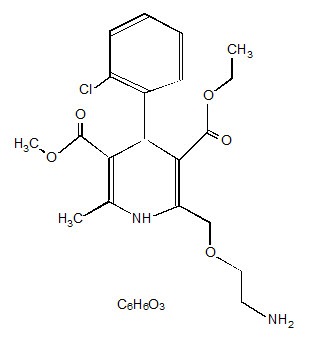
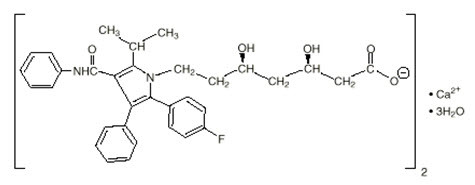
Amlodipine besylate
        Atorvastatin calcium
CADUET contains amlodipine besylate, a white to off-white crystalline powder, and atorvastatin calcium, also a white to off-white crystalline powder. Amlodipine besylate has a molecular weight of 567.1 and atorvastatin calcium has a molecular weight of 1209.42. Amlodipine besylate is slightly soluble in water and sparingly soluble in ethanol. Atorvastatin calcium is insoluble in aqueous solutions of pH 4 and below. Atorvastatin calcium is very slightly soluble in distilled water, pH 7.4 phosphate buffer, and acetonitrile; slightly soluble in ethanol; and freely soluble in methanol.
CADUET is available as film-coated tablets containing:
• 5 mg amlodipine equivalent to 6.9 mg amlodipine besylate and 10 mg atorvastatin equivalent to 10.4 mg atorvastatin calcium.• 5 mg amlodipine equivalent to 6.9 mg amlodipine besylate and 20 mg atorvastatin equivalent to 20.7 mg atorvastatin calcium.• 5 mg amlodipine equivalent to 6.9 mg amlodipine besylate and 40 mg atorvastatin equivalent to 41.4 mg atorvastatin calcium.• 5 mg amlodipine equivalent to 6.9 mg amlodipine besylate and 80 mg atorvastatin equivalent to 82.9 mg atorvastatin calcium.• 10 mg amlodipine equivalent to 13.9 mg amlodipine besylate and 10 mg atorvastatin equivalent to 10.4 mg atorvastatin calcium.• 10 mg amlodipine equivalent to 13.9 mg amlodipine besylate and 20 mg atorvastatin equivalent to 20.7 mg atorvastatin calcium.• 10 mg amlodipine equivalent to 13.9 mg amlodipine besylate and 40 mg atorvastatin equivalent to 41.4 mg atorvastatin calcium.• 10 mg amlodipine equivalent to 13.9 mg amlodipine besylate and 80 mg atorvastatin equivalent to 82.9 mg atorvastatin calcium.
Each film-coated tablet also contains calcium carbonate, croscarmellose sodium, microcrystalline cellulose, pregelatinized starch, polysorbate 80, hydroxypropyl cellulose, purified water, colloidal silicon dioxide (anhydrous), magnesium stearate, Opadry® II White 85F28751 (polyvinyl alcohol, titanium dioxide, PEG 3000, and talc) or Opadry® II Blue 85F10919 (polyvinyl alcohol, titanium dioxide, PEG 3000, talc, and FD&C blue #2).
12 Clinical Pharmacology
12.1Mechanism of Action
CADUET is a combination of two drugs, a dihydropyridine calcium channel blocker (amlodipine) and an HMG-CoA reductase inhibitor (atorvastatin). The amlodipine component of CADUET inhibits the transmembrane influx of calcium ions into vascular smooth muscle and cardiac muscle. The atorvastatin component of CADUET is a selective, competitive inhibitor of HMG-CoA reductase, the rate-limiting enzyme that converts 3-hydroxy-3-methylglutaryl-coenzyme A to mevalonate, a precursor of sterols, including cholesterol.
Amlodipine
Amlodipine binds to both dihydropyridine and nondihydropyridine binding sites. The contractile processes of cardiac muscle and vascular smooth muscle are dependent upon the movement of extracellular calcium ions into these cells through specific ion channels. Amlodipine inhibits calcium ion influx across cell membranes selectively, with a greater effect on vascular smooth muscle cells than on cardiac muscle cells. Negative inotropic effects can be detected in vitro but such effects have not been seen in intact animals at therapeutic doses. Serum calcium concentration is not affected by amlodipine.
Amlodipine is a peripheral arterial vasodilator that acts directly on vascular smooth muscle to cause a reduction in peripheral vascular resistance and reduction in blood pressure.
The precise mechanisms by which amlodipine relieves angina have not been fully delineated, but are thought to include the following:
Exertional Angina: In patients with exertional angina, amlodipine reduces the total peripheral resistance (afterload) against which the heart works and reduces the rate pressure product, and thus myocardial oxygen demand, at any given level of exercise.
Vasospastic Angina: Amlodipine has been demonstrated to block constriction and restore blood flow in coronary arteries and arterioles in response to calcium, potassium epinephrine, serotonin, and thromboxane A2 analog in experimental animal models and in human coronary vessels in vitro. This inhibition of coronary spasm is responsible for the effectiveness of amlodipine in vasospastic (Prinzmetal's or variant) angina.
Atorvastatin
Atorvastatin is a selective, competitive inhibitor of HMG-CoA reductase, the rate-limiting enzyme that converts 3-hydroxy-3-methylglutaryl-coenzyme A to mevalonate, a precursor of sterols, including cholesterol. In animal models, atorvastatin lowers plasma cholesterol and lipoprotein levels by inhibiting HMG-CoA reductase and cholesterol synthesis in the liver and by increasing the number of hepatic LDL receptors on the cell surface to enhance uptake and catabolism of LDL; atorvastatin also reduces LDL production and the number of LDL particles.
12.2 Pharmacodynamics
Amlodipine
Following administration of therapeutic doses to patients with hypertension, amlodipine produces vasodilation resulting in a reduction of supine and standing blood pressures. These decreases in blood pressure are not accompanied by a significant change in heart rate or plasma catecholamine levels with chronic dosing. Although the acute intravenous administration of amlodipine decreases arterial blood pressure and increases heart rate in hemodynamic studies of patients with chronic stable angina, chronic oral administration of amlodipine in clinical trials did not lead to clinically significant changes in heart rate or blood pressures in normotensive patients with angina.
With chronic once daily oral administration, antihypertensive effectiveness is maintained for at least 24 hours. Plasma concentrations correlate with effect in both young and elderly patients. The magnitude of reduction in blood pressure with amlodipine is also correlated with the height of pretreatment elevation; thus, individuals with moderate hypertension (diastolic pressure 105–114 mmHg) had about a 50% greater response than patients with mild hypertension (diastolic pressure 90–104 mmHg). Normotensive subjects experienced no clinically significant change in blood pressures (+1/–2 mmHg).
In hypertensive patients with normal renal function, therapeutic doses of amlodipine resulted in a decrease in renal vascular resistance and an increase in glomerular filtration rate and effective renal plasma flow without change in filtration fraction or proteinuria.
As with other calcium channel blockers, hemodynamic measurements of cardiac function at rest and during exercise (or pacing) in patients with normal ventricular function treated with amlodipine have generally demonstrated a small increase in cardiac index without significant influence on dP/dt or on left ventricular end diastolic pressure or volume. In hemodynamic studies, amlodipine has not been associated with a negative inotropic effect when administered in the therapeutic dose range to intact animals and man, even when co-administered with beta-blockers to man. Similar findings, however, have been observed in normal or well-compensated patients with heart failure with agents possessing significant negative inotropic effects.
Amlodipine does not change sinoatrial nodal function or atrioventricular conduction in intact animals or man. In patients with chronic stable angina, intravenous administration of 10 mg did not significantly alter A-H and H-V conduction and sinus node recovery time after pacing. Similar results were obtained in patients receiving amlodipine and concomitant beta-blockers. In clinical studies in which amlodipine was administered in combination with beta-blockers to patients with either hypertension or angina, no adverse effects on electrocardiographic parameters were observed. In clinical trials with angina patients alone, amlodipine therapy did not alter electrocardiographic intervals or produce higher degrees of AV blocks.
Atorvastatin
Atorvastatin, as well as some of its metabolites, are pharmacologically active in humans. The liver is the primary site of action and the principal site of cholesterol synthesis and LDL clearance. Drug dosage, rather than systemic drug concentration, correlates better with LDL-C reduction. Individualization of drug dosage should be based on therapeutic response [see Dosage and Administration (2)].
Drug interactions
Sildenafil: When amlodipine and sildenafil were used in combination, each agent independently exerted its own blood pressure lowering effect [see Drug Interactions (7.1)].
12.3 Pharmacokinetics
Absorption
Amlodipine: After oral administration of therapeutic doses of amlodipine alone, absorption produces peak plasma concentrations between 6 and 12 hours. Absolute bioavailability has been estimated to be between 64% and 90%.
Atorvastatin: After oral administration alone, atorvastatin is rapidly absorbed; maximum plasma concentrations occur within 1 to 2 hours. Extent of absorption increases in proportion to atorvastatin dose. The absolute bioavailability of atorvastatin (parent drug) is approximately 14% and the systemic availability of HMG-CoA reductase inhibitory activity is approximately 30%. The low systemic availability is attributed to presystemic clearance in gastrointestinal mucosa and/or hepatic first-pass metabolism. Plasma atorvastatin concentrations are lower (approximately 30% for Cmax and AUC) following evening drug administration compared with morning. However, LDL-C reduction is the same regardless of the time of day of drug administration [see Dosage and Administration (2)].
CADUET: Following oral administration of CADUET, peak plasma concentrations of amlodipine and atorvastatin are seen at 6 to 12 hours and 1 to 2 hours post dosing, respectively. The rate and extent of absorption (bioavailability) of amlodipine and atorvastatin from CADUET are not significantly different from the bioavailability of amlodipine and atorvastatin administered separately (see above).
The bioavailability of amlodipine from CADUET was not affected by food. Food decreases the rate and extent of absorption of atorvastatin from CADUET by approximately 32% and 11%, respectively, as it does with atorvastatin when given alone. LDL-C reduction is similar whether atorvastatin is given with or without food.
Distribution
Amlodipine: Ex vivo studies have shown that approximately 93% of the circulating amlodipine drug is bound to plasma proteins in hypertensive patients. Steady-state plasma levels of amlodipine are reached after 7 to 8 days of consecutive daily dosing.
Atorvastatin: Mean volume of distribution of atorvastatin is approximately 381 liters. Atorvastatin is ≥98% bound to plasma proteins. A blood/plasma ratio of approximately 0.25 indicates poor drug penetration into red blood cells. Based on observations in rats, atorvastatin calcium is likely to be secreted in human milk [see Contraindications (4) and Use in Specific Populations (8.3)].
Metabolism
Amlodipine: Amlodipine is extensively (about 90%) converted to inactive metabolites via hepatic metabolism.
Atorvastatin: Atorvastatin is extensively metabolized to ortho- and parahydroxylated derivatives and various beta-oxidation products. In vitro inhibition of HMG-CoA reductase by ortho- and parahydroxylated metabolites is equivalent to that of atorvastatin. Approximately 70% of circulating inhibitory activity for HMG-CoA reductase is attributed to active metabolites.
In vitro studies suggest the importance of atorvastatin metabolism by cytochrome P4503A4, consistent with increased plasma concentrations of atorvastatin in humans following co-administration with erythromycin, a known inhibitor of this isozyme [see Drug Interactions (7)]. In animals, the ortho-hydroxy metabolite undergoes further glucuronidation.
Excretion
Amlodipine: Elimination from the plasma is biphasic with a terminal elimination half-life of about 30–50 hours. Ten percent of the parent amlodipine compound and 60% of the metabolites of amlodipine are excreted in the urine.
Atorvastatin: Atorvastatin and its metabolites are eliminated primarily in bile following hepatic and/or extra-hepatic metabolism; however, the drug does not appear to undergo enterohepatic recirculation. Mean plasma elimination half-life of atorvastatin in humans is approximately 14 hours, but the half-life of inhibitory activity for HMG-CoA reductase is 20 to 30 hours because of the contribution of active metabolites. Less than 2% of a dose of atorvastatin is recovered in urine following oral administration.
Specific Populations
Geriatric
Pediatric
Gender
Renal Impairment
Hemodialysis
While studies have not been conducted in patients with end-stage renal disease, hemodialysis is not expected to clear atorvastatin or amlodipine since both drugs are extensively bound to plasma proteins.
Hepatic Impairment
Heart Failure
Effects of Other Drugs on CADUET
Amlodipine:
Co-administered cimetidine, magnesium-and aluminum hydroxide antacids, sildenafil, and grapefruit juice have no impact on the exposure to amlodipine.
Atorvastatin:
Atorvastatin is a substrate of the hepatic transporters, OATP1B1 and OATP1B3 transporter. Metabolites of atorvastatin are substrates of OATP1B1. Atorvastatin is also identified as a substrate of the efflux transporter BCRP, which may limit the intestinal absorption and biliary clearance of atorvastatin.
Table 6 shows effects of other drugs on the pharmacokinetics of atorvastatin.
Table 6. Effect of Co-administered Drugs on the Pharmacokinetics of Atorvastatin Co-administered drug and dosing regimen Atorvastatin Dose (mg) Ratio of AUC Represents ratio of treatments (co-administered drug plus atorvastatin vs atorvastatin alone). Ratio of Cmax
See Sections 5.1 and 7 for clinical significance. Cyclosporine 5.2 mg/kg/day, stable dose
10 mg QDOnce daily for 28 days
8.69
10.66
Tipranavir 500 mg BID Twice daily /ritonavir 200 mg BID, 7 days
10 mg SDSingle dose
9.36
8.58
Glecaprevir 400 mg QD /pibrentasvir 120 mg QD , 7 days
10 mg QDfor 7 days
8.28
22.00
Telaprevir 750 mg q8h Every 8 hours , 10 days
20 mg SD
7.88
10.60
, The dose of saquinavir plus ritonavir in this study is not the clinically used dose. The increase in atorvastatin exposure when used clinically is likely to be higher than what was observed in this study. Therefore, caution should be applied and the lowest dose necessary should be used. Saquinavir 400 mg BID/ritonavir 400 mg BID , 15 days
40 mg QDfor 4 days
3.93
4.31
Elbasvir 50 mg QD /grazoprevir 200 mg QD , 13 days
10 mg SD
1.95
4.34
Simeprevir 150 mg QD , 10 days
40 mg SD
2.12
1.70
Clarithromycin 500 mg BID , 9 days
80 mg QDfor 8 days
4.54
5.38
Darunavir 300 mg BID /ritonavir 100 mg BID , 9 days
10 mg QDfor 4 days
3.45
2.25
Itraconazole 200 mg QD , 4 days
40 mg SD
3.32
1.20
Letermovir 480 mg QD , 10 days
20 mg SD
3.29
2.17
Fosamprenavir 700 mg BID /ritonavir 100 mg BID , 14 days
10 mg QDfor 4 days
2.53
2.84
Fosamprenavir 1400 mg BID , 14 days
10 mg QDfor 4 days
2.30
4.04
Nelfinavir 1250 mg BID , 14 days
10 mg QDfor 28 days
1.74
2.22
Grapefruit Juice, 240 mL QD , Greater increases in AUC (ratio of AUC up to 2.5) and/or Cmax (ratio of Cmax up to 1.71) have been reported with excessive grapefruit consumption (≥ 750 mL – 1.2 liters per day).
40 mg SD
1.37
1.16
Diltiazem 240 mg QD, 28 days
40 mg SD
1.51
1.00
Erythromycin 500 mg QIDFour times daily , 7 days
10 mg SD
1.33
1.38
Amlodipine 10 mg, single dose
80 mg SD
1.18
0.91
Cimetidine 300 mg QID, 2 weeks
10 mg QDfor 2 weeks
1.00
0.89
Colestipol 10 g BID, 24 weeks
40 mg QDfor 8 weeks
NA
0.74Ratio based on a single sample taken 8–16 h post dose.
Maalox TC® 30 mL QID, 17 days
10 mg QDfor 15 days
0.66
0.67
Efavirenz 600 mg QD, 14 days
10 mg for 3 days
0.59
1.01
Rifampin 600 mg QD , 7 days (co-administered) Due to the dual interaction mechanism of rifampin, simultaneous co-administration of atorvastatin with rifampin is recommended, as delayed administration of atorvastatin after administration of rifampin has been associated with a significant reduction in atorvastatin plasma concentrations.
40 mg SD
1.12
2.90
Rifampin 600 mg QD , 5 days (doses separated)
40 mg SD
0.20
0.60
Gemfibrozil 600 mg BID , 7 days
40 mg SD
1.35
1.00
Fenofibrate 160 mg QD , 7 days
40 mg SD
1.03
1.02
Boceprevir 800 mg TIDThree times daily , 7 days
40 mg SD
2.32
2.66
Effects of CADUET on Other Drugs
Amlodipine:
Amlodipine is a weak inhibitor of CYP3A and may increase exposure to CYP3A substrates.
In vitro data indicate that amlodipine has no effect on the human plasma protein binding of digoxin, phenytoin, warfarin, and indomethacin.
Co-administered amlodipine does not affect the exposure to atorvastatin, digoxin, ethanol and the warfarin prothrombin response time.
Atorvastatin:
Table 7 shows the effects of atorvastatin on the pharmacokinetics of other drugs.
Table 7. Effect of Atorvastatin on the Pharmacokinetics of Co-administered Drugs Atorvastatin Co-administered drug and dosing regimen Drug/Dose (mg) Ratio of AUC Ratio of Cmax
80 mg QDOnce daily for 15 days
Antipyrine, 600 mg SDSingle dose
1.03
0.89
80 mg QDfor 10 days
See Section 7 for clinical significance. Digoxin 0.25 mg QD, 20 days
1.15
1.20
40 mg QDfor 22 days
Oral contraceptive QD, 2 months
– norethindrone 1 mg– ethinyl estradiol 35 µg
1.281.19
1.231.30
10 mg SD
Tipranavir 500 mg BIDTwice daily /ritonavir 200 mg BID, 7 days
1.08
0.96
10 mg QDfor 4 days
Fosamprenavir 1400 mg BID, 14 days
0.73
0.82
10 mg QDfor 4 days
Fosamprenavir 700 mg BID/ritonavir 100 mg BID , 14 days
0.99
0.94
Atorvastatin had no clinically significant effect on prothrombin time when administered to patients receiving chronic warfarin treatment.
13 Nonclinical Toxicology
13.1Carcinogenesis, Mutagenesis, Impairment of Fertility
Amlodipine
Rats and mice treated with amlodipine maleate in the diet for up to two years, at concentrations calculated to provide daily dosage levels of 0.5, 1.25, and 2.5 mg amlodipine/kg/day, showed no evidence of a carcinogenic effect of the drug. For the mouse, the highest dose was, on a mg/m2 basis, similar to the MRHD of 10 mg amlodipine/day.Based on patient weight of 50 kg. For the rat, the highest dose level was, on a mg/m2 basis, about twice the MRHD.
Mutagenicity studies conducted with amlodipine maleate revealed no drug related effects at either the gene or chromosome levels.
There was no effect on the fertility of rats treated orally with amlodipine maleate (males for 64 days and females for 14 days prior to mating) at doses up to 10 mg amlodipine/kg/day (8 times the MRHDof 10 mg/day on a mg/m2 basis).
Atorvastatin
In a 2-year carcinogenicity study with atorvastatin calcium in rats at dose levels equivalent to 10, 30, and 100 mg atorvastatin/kg/day, 2 rare tumors were found in muscle in high-dose females: in one, there was a rhabdomyosarcoma and, in another, there was a fibrosarcoma. This dose represents a plasma AUC (0–24) value of approximately 16 times the mean human plasma drug exposure after an 80 mg oral dose.
A 2-year carcinogenicity study in mice given atorvastatin calcium at dose levels equivalent to 100, 200, or 400 mg atorvastatin/kg/day resulted in a significant increase in liver adenomas in high-dose males and liver carcinomas in high-dose females. These findings occurred at plasma AUC (0–24) values of approximately 6 times the mean human plasma drug exposure after an 80 mg oral dose.
In vitro, atorvastatin was not mutagenic or clastogenic in the following tests with and without metabolic activation: the Ames test with Salmonella typhimurium and Escherichia coli, the HGPRT forward mutation assay in Chinese hamster lung cells, and the chromosomal aberration assay in Chinese hamster lung cells. Atorvastatin was negative in the in vivo mouse micronucleus test.
In female rats, atorvastatin at doses up to 225 mg/kg (56 times the human exposure) did not cause adverse effects on fertility. Studies in male rats performed at doses up to 175 mg/kg (15 times the human exposure) produced no changes in fertility. There was aplasia and aspermia in the epididymides of 2 of 10 rats treated with atorvastatin calcium at a dose equivalent to 100 mg atorvastatin/kg/day for 3 months (16 times the human AUC at the 80 mg dose); testis weights were significantly lower at 30 and 100 mg/kg/day and epididymal weight was lower at 100 mg/kg/day. Male rats given the equivalent of 100 mg atorvastatin/kg/day for 11 weeks prior to mating had decreased sperm motility, spermatid head concentration, and increased abnormal sperm. Atorvastatin caused no adverse effects on semen parameters, or reproductive organ histopathology in dogs given doses of atorvastatin calcium equivalent to 10, 40, or 120 mg atorvastatin/kg/day for two years.
14 Clinical Studies
14.1 Amlodipine for Hypertension
Adult Patients
The antihypertensive efficacy of amlodipine has been demonstrated in a total of 15 double-blind, placebo-controlled, randomized studies involving 800 patients on amlodipine and 538 on placebo. Once daily administration produced statistically significant placebo-corrected reductions in supine and standing blood pressures at 24 hours postdose, averaging about 12/6 mmHg in the standing position and 13/7 mmHg in the supine position in patients with mild to moderate hypertension. Maintenance of the blood pressure effect over the 24-hour dosing interval was observed, with little difference in peak and trough effect. Tolerance was not demonstrated in patients studied for up to 1 year. The 3 parallel, fixed dose, dose response studies showed that the reduction in supine and standing blood pressures was dose related within the recommended dosing range. Effects on diastolic pressure were similar in young and older patients. The effect on systolic pressure was greater in older patients, perhaps because of greater baseline systolic pressure. Effects were similar in black patients and in white patients.
Pediatric Patients
Two hundred sixty-eight hypertensive patients aged 6 to 17 years were randomized first to amlodipine 2.5 or 5 mg once daily for 4 weeks and then randomized again to the same dose or to placebo for another 4 weeks. Patients receiving 2.5 mg or 5 mg at the end of 8 weeks had significantly lower systolic blood pressure than those secondarily randomized to placebo. The magnitude of the treatment effect is difficult to interpret, but it is probably less than 5 mmHg systolic on the 5 mg dose and 3.3 mmHg systolic on the 2.5 mg dose. Adverse events were similar to those seen in adults.
14.2Amlodipine for Chronic Stable Angina
The effectiveness of 5–10 mg/day of amlodipine in exercise-induced angina has been evaluated in 8 placebo-controlled, double-blind clinical trials of up to 6 weeks duration involving 1038 patients (684 amlodipine, 354 placebo) with chronic stable angina. In 5 of the 8 studies, significant increases in exercise time (bicycle or treadmill) were seen with the 10 mg dose. Increases in symptom-limited exercise time averaged 12.8% (63 sec) for amlodipine 10 mg, and averaged 7.9% (38 sec) for amlodipine 5 mg. Amlodipine 10 mg also increased time to 1 mm ST segment deviation in several studies and decreased angina attack rate. The sustained efficacy of amlodipine in angina patients has been demonstrated over long-term dosing. In patients with angina, there were no clinically significant reductions in blood pressures (4/1 mmHg) or changes in heart rate (+0.3 bpm).
14.3Amlodipine for Vasospastic Angina
In a double-blind, placebo-controlled clinical trial of 4 weeks duration in 50 patients, amlodipine therapy decreased attacks by approximately 4/week compared with a placebo decrease of approximately 1/week (p<0.01). Two of 23 amlodipine and 7 of 27 placebo patients discontinued from the study for lack of clinical improvement.
14.4Amlodipine for Coronary Artery Disease
In PREVENT, 825 patients with angiographically documented CAD were randomized to amlodipine (5–10 mg once daily) or placebo and followed for 3 years. Although the study did not show significance on the primary objective of change in coronary luminal diameter as assessed by quantitative coronary angiography, the data suggested a favorable outcome with respect to fewer hospitalizations for angina and revascularization procedures in patients with CAD.
CAMELOT enrolled 1318 patients with CAD recently documented by angiography, without left main coronary disease and without heart failure or an ejection fraction <40%. Patients (76% males, 89% Caucasian, 93% enrolled at U.S. sites, 89% with a history of angina, 52% without PCI, 4% with PCI and no stent, and 44% with a stent) were randomized to double-blind treatment with either amlodipine (5–10 mg once daily) or placebo in addition to standard care that included aspirin (89%), statins (83%), beta-blockers (74%), nitroglycerin (50%), anticoagulants (40%), and diuretics (32%), but excluded other calcium channel blockers. The mean duration of follow-up was 19 months. The primary endpoint was the time to first occurrence of one of the following events: hospitalization for angina pectoris, coronary revascularization, myocardial infarction, cardiovascular death, resuscitated cardiac arrest, hospitalization for heart failure, stroke/TIA, or peripheral vascular disease. A total of 110 (16.6%) and 151 (23.1%) first events occurred in the amlodipine and placebo groups, respectively, for a hazard ratio of 0.691 (95% CI: 0.540–0.884, p = 0.003). The primary endpoint is summarized in Figure 1 below. The outcome of this study was largely derived from the prevention of hospitalizations for angina and the prevention of revascularization procedures (see Table 8). Effects in various subgroups are shown in Figure 2.
In an angiographic substudy (n=274) conducted within CAMELOT, there was no significant difference between amlodipine and placebo on the change of atheroma volume in the coronary artery as assessed by intravascular ultrasound.
Figure 1. Kaplan-Meier Analysis of Composite Clinical Outcomes for Amlodipine versus Placebo

Figure 2. Effects on Primary Endpoint of Amlodipine versus Placebo across Sub-Groups
Table 8 below summarizes the significant composite endpoint and clinical outcomes from the composites of the primary endpoint. The other components of the primary endpoint including cardiovascular death, resuscitated cardiac arrest, myocardial infarction, hospitalization for heart failure, stroke/TIA, or peripheral vascular disease did not demonstrate a significant difference between amlodipine and placebo.
Table 8. Incidence of Significant Clinical Outcomes for CAMELOT Clinical Outcomes N (%) Amlodipine (N=663) Placebo (N=655) Risk Reduction (p-value)
Composite CV Endpoint
110 (16.6)
151 (23.1)
31% (0.003)
Hospitalization for AnginaTotal patients with these events.
51(7.7)
84(12.8)
42%(0.002)
Coronary Revascularization
78(11.8)
103(15.7)
27%(0.033)
14.5Amlodipine for Heart Failure
Amlodipine has been compared to placebo in four 8–12 week studies of patients with NYHA Class II/III heart failure, involving a total of 697 patients. In these studies, there was no evidence of worsened heart failure based on measures of exercise tolerance, NYHA classification, symptoms, or left ventricular ejection fraction. In a long-term (follow-up at least 6 months, mean 13.8 months) placebo-controlled mortality/morbidity study of amlodipine 5–10 mg in 1153 patients with NYHA Classes III (n=931) or IV (n=222) heart failure on stable doses of diuretics, digoxin, and ACE inhibitors, amlodipine had no effect on the primary endpoint of the study which was the combined endpoint of all-cause mortality and cardiac morbidity (as defined by life-threatening arrhythmia, acute myocardial infarction, or hospitalization for worsened heart failure), or on NYHA classification, or symptoms of heart failure. Total combined all-cause mortality and cardiac morbidity events were 222/571 (39%) for patients on amlodipine and 246/583 (42%) for patients on placebo; the cardiac morbid events represented about 25% of the endpoints in the study.
Another study (PRAISE-2) randomized patients with NYHA Class III (80%) or IV (20%) heart failure without clinical symptoms or objective evidence of underlying ischemic disease, on stable doses of ACE inhibitors (99%), digitalis (99%), and diuretics (99%), to placebo (n=827) or amlodipine (n=827) and followed them for a mean of 33 months. There was no statistically significant difference between amlodipine and placebo in the primary endpoint of all-cause mortality (95% confidence limits from 8% reduction to 29% increase on amlodipine). With amlodipine there were more reports of pulmonary edema.
14.6Atorvastatin for Prevention of Cardiovascular Disease
In the Anglo-Scandinavian Cardiac Outcomes Trial (ASCOT), the effect of atorvastatin on fatal and non-fatal coronary heart disease was assessed in 10,305 hypertensive patients 40–80 years of age (mean of 63 years), without a previous myocardial infarction and with total-C levels ≤ 251 mg/dL (6.5 mmol/L). Additionally, all patients had at least 3 of the following cardiovascular risk factors: male gender (81.1%), age > 55 years (84.5%), smoking (33.2%), diabetes (24.3%), history of CHD in a first-degree relative (26%), TC:HDL > 6 (14.3%), peripheral vascular disease (5.1%), left ventricular hypertrophy (14.4%), prior cerebrovascular event (9.8%), specific ECG abnormality (14.3%), proteinuria/albuminuria (62.4%). In this double-blind, placebo-controlled study, patients were treated with anti-hypertensive therapy (Goal BP < 140/90 mmHg for non-diabetic patients; < 130/80 mm Hg for diabetic patients) and allocated to either atorvastatin 10 mg daily (n=5168) or placebo (n=5137), using a covariate adaptive method that took into account the distribution of nine baseline characteristics of patients already enrolled and minimized the imbalance of those characteristics across the groups. Patients were followed for a median duration of 3.3 years.
The effect of 10 mg/day of atorvastatin on lipid levels was similar to that seen in previous clinical trials.
Atorvastatin significantly reduced the rate of coronary events [either fatal coronary heart disease (46 events in the placebo group vs. 40 events in the atorvastatin group) or non-fatal MI (108 events in the placebo group vs. 60 events in the atorvastatin group)] with a relative risk reduction of 36% [(based on incidences of 1.9% for atorvastatin vs. 3.0% for placebo), p=0.0005 (see Figure 3)]. The risk reduction was consistent regardless of age, smoking status, obesity, or presence of renal dysfunction. The effect of atorvastatin was seen regardless of baseline LDL levels. Because of the small number of events, results for women were inconclusive.
Figure 3. Effect of Atorvastatin 10 mg/day on Cumulative Incidence of Non-Fatal Myocardial Infarction or Coronary Heart Disease Death (in ASCOT-LLA)
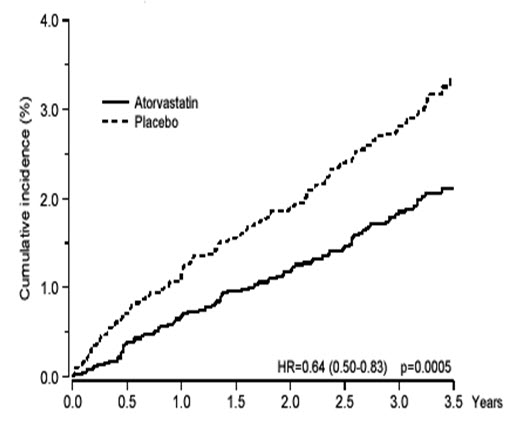
Atorvastatin also significantly decreased the relative risk for revascularization procedures by 42% (incidences of 1.4% for atorvastatin and 2.5% for placebo). Although the reduction of fatal and non-fatal strokes did not reach a pre-defined significance level (p=0.01), a favorable trend was observed with a 26% relative risk reduction (incidences of 1.7% for atorvastatin and 2.3% for placebo). There was no significant difference between the treatment groups for death from cardiovascular causes (p=0.51) or noncardiovascular causes (p=0.17).
In the Collaborative Atorvastatin Diabetes Study (CARDS), the effect of atorvastatin on cardiovascular disease endpoints was assessed in 2838 subjects (94% white, 68% male), ages 40–75 with type 2 diabetes based on WHO criteria, without prior history of cardiovascular disease, and with LDL ≤ 160 mg/dL and TG ≤ 600 mg/dL. In addition to diabetes, subjects had 1 or more of the following risk factors: current smoking (23%), hypertension (80%), retinopathy (30%), or microalbuminuria (9%) or macroalbuminuria (3%). No subjects on hemodialysis were enrolled in the study. In this multicenter, placebo-controlled, double-blind clinical trial, subjects were randomly allocated to either atorvastatin 10 mg daily (1,429) or placebo (1,411) in a 1:1 ratio and were followed for a median duration of 3.9 years. The primary endpoint was the occurrence of any of the major cardiovascular events: myocardial infarction, acute CHD death, unstable angina, coronary revascularization, or stroke. The primary analysis was the time to first occurrence of the primary endpoint.
Baseline characteristics of subjects were: mean age of 62 years; mean HbA1c 7.7%; median LDL-C 120 mg/dL; median total-C 207 mg/dL; median TG 151 mg/dL; median HDL-C 52 mg/dL.
The effect of atorvastatin 10 mg/day on lipid levels was similar to that seen in previous clinical trials.
Atorvastatin significantly reduced the rate of major cardiovascular events (primary endpoint events) (83 events in the atorvastatin group vs. 127 events in the placebo group) with a relative risk reduction of 37%, HR 0.63, 95% CI (0.48, 0.83) (p=0.001) (see Figure 4). An effect of atorvastatin was seen regardless of age, sex, or baseline lipid levels.
Atorvastatin significantly reduced the risk of stroke by 48% (21 events in the atorvastatin group vs. 39 events in the placebo group), HR 0.52, 95% CI (0.31, 0.89) (p=0.016) and reduced the risk of MI by 42% (38 events in the atorvastatin group vs. 64 events in the placebo group), HR 0.58, 95.1% CI (0.39, 0.86) (p=0.007). There was no significant difference between the treatment groups for angina, revascularization procedures, and acute CHD death.
There were 61 deaths in the atorvastatin group vs. 82 deaths in the placebo group (HR 0.73, p=0.059).
Figure 4. Effect of Atorvastatin 10 mg/day on Time to Occurrence of Major Cardiovascular Events (myocardial infarction, acute CHD death, unstable angina, coronary revascularization, or stroke) in CARDS
In the Treating to New Targets Study (TNT), the effect of atorvastatin 80 mg/day vs. atorvastatin 10 mg/day on the reduction in cardiovascular events was assessed in 10,001 subjects (94% white, 81% male, 38% ≥ 65 years) with clinically evident coronary heart disease who had achieved a target LDL-C level < 130 mg/dL after completing an 8-week, open-label, run-in period with atorvastatin 10 mg/day. Subjects were randomly assigned to either 10 mg/day or 80 mg/day of atorvastatin and followed for a median duration of 4.9 years. The primary endpoint was the time to first occurrence of any of the following major cardiovascular events (MCVE): death from CHD, non-fatal myocardial infarction, resuscitated cardiac arrest, and fatal and non-fatal stroke. The mean LDL-C, TC, TG, non-HDL, and HDL-C levels at 12 weeks were 73, 145, 128, 98, and 47 mg/dL during treatment with 80 mg of atorvastatin and 99, 177, 152, 129, and 48 mg/dL during treatment with 10 mg of atorvastatin.
Treatment with atorvastatin 80 mg/day significantly reduced the rate of MCVE (434 events in the 80 mg/day group vs. 548 events in the 10 mg/day group) with a relative risk reduction of 22%, HR 0.78, 95% CI (0.69, 0.89), p=0.0002 (see Figure 5 and Table 9). The overall risk reduction was consistent regardless of age (< 65, ≥ 65) or gender.
Figure 5. Effect of Atorvastatin 80 mg/day vs. 10 mg/day on Time to Occurrence of Major Cardiovascular Events (TNT)
Table 9. Overview of Efficacy Results in TNT Endpoint Atorvastatin 10 mg (N=5006) Atorvastatin 80 mg (N=4995) HR Atorvastatin 80 mg: atorvastatin 10 mg (95% CI)PRIMARY ENDPOINT n (%) n (%) HR=hazard ratio; CHD=coronary heart disease; CI=confidence interval; MI=myocardial infarction; CHF=congestive heart failure; CV=cardiovascular; PVD=peripheral vascular disease; CABG=coronary artery bypass graftConfidence intervals for the Secondary Endpoints were not adjusted for multiple comparisons.
First major cardiovascular endpoint
548
(10.9)
434
(8.7)
0.78 (0.69, 0.89)
Components of the Primary Endpoint
CHD death
127
(2.5)
101
(2.0)
0.80 (0.61, 1.03)
Non-fatal, non-procedure related MI
308
(6.2)
243
(4.9)
0.78 (0.66, 0.93)
Resuscitated cardiac arrest
26
(0.5)
25
(0.5)
0.96 (0.56, 1.67)
Stroke (fatal and non-fatal)
155
(3.1)
117
(2.3)
0.75 (0.59, 0.96)
SECONDARY ENDPOINTSSecondary endpoints not included in primary endpoint
First CHF with hospitalization
164
(3.3)
122
(2.4)
0.74 (0.59, 0.94)
First PVD endpoint
282
(5.6)
275
(5.5)
0.97 (0.83, 1.15)
First CABG or other coronary revascularization procedureComponent of other secondary endpoints
904
(18.1)
667
(13.4)
0.72 (0.65, 0.80)
First documented angina endpoint
615
(12.3)
545
(10.9)
0.88 (0.79, 0.99)
All-cause mortality
282
(5.6)
284
(5.7)
1.01 (0.85, 1.19)
Components of All-Cause Mortality
Cardiovascular death
155
(3.1)
126
(2.5)
0.81 (0.64, 1.03)
Noncardiovascular death
127
(2.5)
158
(3.2)
1.25 (0.99, 1.57)
Cancer death
75
(1.5)
85
(1.7)
1.13 (0.83, 1.55)
Other non-CV death
43
(0.9)
58
(1.2)
1.35 (0.91, 2.00)
Suicide, homicide, and other traumatic non-CV death
9
(0.2)
15
(0.3)
1.67 (0.73, 3.82)
Of the events that comprised the primary efficacy endpoint, treatment with atorvastatin 80 mg/day significantly reduced the rate of non-fatal, non-procedure related MI and fatal and non-fatal stroke, but not CHD death or resuscitated cardiac arrest (Table 9). Of the predefined secondary endpoints, treatment with atorvastatin 80 mg/day significantly reduced the rate of coronary revascularization, angina, and hospitalization for heart failure, but not peripheral vascular disease. The reduction in the rate of CHF with hospitalization was only observed in the 8% of patients with a prior history of CHF.
There was no significant difference between the treatment groups for all-cause mortality (Table 9). The proportions of subjects who experienced cardiovascular death, including the components of CHD death and fatal stroke, were numerically smaller in the atorvastatin 80 mg group than in the atorvastatin 10 mg treatment group. The proportions of subjects who experienced noncardiovascular death were numerically larger in the atorvastatin 80 mg group than in the atorvastatin 10 mg treatment group.
In the Incremental Decrease in Endpoints Through Aggressive Lipid Lowering Study (IDEAL), treatment with atorvastatin 80 mg/day was compared to treatment with simvastatin 20–40 mg/day in 8,888 subjects up to 80 years of age with a history of CHD to assess whether reduction in CV risk could be achieved. Patients were mainly male (81%), white (99%) with an average age of 61.7 years, and an average LDL-C of 121.5 mg/dL at randomization; 76% were on statin therapy. In this prospective, randomized, open-label, blinded endpoint (PROBE) trial with no run-in period, subjects were followed for a median duration of 4.8 years. The mean LDL-C, TC, TG, HDL, and non-HDL-C levels at Week 12 were 78, 145, 115, 45, and 100 mg/dL during treatment with 80 mg of atorvastatin and 105, 179, 142, 47, and 132 mg/dL during treatment with 20–40 mg of simvastatin.
There was no significant difference between the treatment groups for the primary endpoint, the rate of first major coronary event (fatal CHD, non-fatal MI, and resuscitated cardiac arrest): 411 (9.3%) in the atorvastatin 80 mg/day group vs. 463 (10.4%) in the simvastatin 20–40 mg/day group, HR 0.89, 95% CI ( 0.78, 1.01), p=0.07.
There were no significant differences between the treatment groups for all-cause mortality: 366 (8.2%) in the atorvastatin 80 mg/day group vs. 374 (8.4%) in the simvastatin 20–40 mg/day group. The proportions of subjects who experienced CV or non-CV death were similar for the atorvastatin 80 mg group and the simvastatin 20–40 mg group.
14.7Atorvastatin for Hyperlipidemia and Mixed Dyslipidemia
Atorvastatin reduces total-C, LDL-C, very-low density lipoprotein cholesterol (VLDL-C), apo B, and TG, and increases HDL-C in patients with hyperlipidemia (heterozygous familial and nonfamilial) and mixed dyslipidemia (Fredrickson Types IIa and IIb). Therapeutic response is seen within 2 weeks, and maximum response is usually achieved within 4 weeks and maintained during chronic therapy.
Atorvastatin is effective in a wide variety of patient populations with hyperlipidemia, with and without hypertriglyceridemia, in men and women, and in the elderly.
In two multicenter, placebo-controlled, dose-response studies in patients with hyperlipidemia, atorvastatin given as a single dose over 6 weeks significantly reduced total-C, LDL-C, apo B, and TG. (Pooled results are provided in Table 10.)
Table 10. Dose Response in Patients with Primary Hyperlipidemia (Adjusted Mean % Change From Baseline) Results are pooled from 2 dose-response studies. Dose N TC LDL-C Apo B TG HDL-C Non-HDL-C/HDL-C
Placebo
21
4
4
3
10
-3
7
10
22
-29
-39
-32
-19
6
-34
20
20
-33
-43
-35
-26
9
-41
40
21
-37
-50
-42
-29
6
-45
80
23
-45
-60
-50
-37
5
-53
In patients with Fredrickson Types IIa and IIb hyperlipoproteinemia pooled from 24 controlled trials, the median (25th and 75th percentile) percent changes from baseline in HDL-C for atorvastatin 10, 20, 40, and 80 mg were 6.4 (-1.4, 14), 8.7 (0, 17), 7.8 (0, 16), and 5.1 (-2.7, 15), respectively. Additionally, analysis of the pooled data demonstrated consistent and significant decreases in total-C, LDL-C, TG, total-C/HDL-C, and LDL-C/HDL-C.
In three multicenter, double-blind studies in patients with hyperlipidemia, atorvastatin was compared to other statins. After randomization, patients were treated for 16 weeks with either atorvastatin 10 mg per day or a fixed dose of the comparative agent (Table 11).
Table 11. Mean Percentage Change from Baseline at Endpoint (Double-Blind, Randomized, Active-Controlled Trials) Treatment (Daily Dose) N Total-C LDL-C Apo B TG HDL-C Non-HDL-C/ HDL-C
Study 1
Atorvastatin 10 mg
707
-27Significantly different from lovastatin, ANCOVA, p ≤ 0.05
-36
-28
-17
+7
-37
Lovastatin 20 mg
191
-19
-27
-20
-6
+7
-28
95% CI for DiffA negative value for the 95% CI for the difference between treatments favors atorvastatin for all except HDL-C, for which a positive value favors atorvastatin. If the range does not include 0, this indicates a statistically significant difference.
-9.2, -6.5
-10.7, -7.1
-10.0, -6.5
-15.2, -7.1
-1.7, 2.0
-11.1, -7.1
Study 2
Atorvastatin 10 mg
222
-25Significantly different from pravastatin, ANCOVA, p ≤ 0.05
-35
-27
-17
+6
-36
Pravastatin 20 mg
77
-17
-23
-17
-9
+8
-28
95% CI for Diff
-10.8, -6.1
-14.5, -8.2
-13.4, -7.4
-14.1, -0.7
-4.9, 1.6
-11.5, -4.1
Study 3
Atorvastatin 10 mg
132
-29Significantly different from simvastatin, ANCOVA, p ≤ 0.05
-37
-34
-23
+7
-39
Simvastatin 10 mg
45
-24
-30
-30
-15
+7
-33
95% CI for Diff
-8.7, -2.7
-10.1, -2.6
-8.0, -1.1
-15.1, -0.7
-4.3, 3.9
-9.6, -1.9
The impact on clinical outcomes of the differences in lipid-altering effects between treatments shown in Table 11 is not known. Table 11 does not contain data comparing the effects of atorvastatin 10 mg and higher doses of lovastatin, pravastatin, and simvastatin. The drugs compared in the studies summarized in the table are not necessarily interchangeable.
14.8 Atorvastatin for Hypertriglyceridemia
The response to atorvastatin in 64 patients with isolated hypertriglyceridemia (Fredrickson Type IV) treated across several clinical trials is shown in the table below (Table 12). For the atorvastatin-treated patients, median (min, max) baseline TG level was 565 (267–1502).
Table 12. Combined Patients with Isolated Elevated TG: Median (min, max) Percentage Change From Baseline Placebo (N=12) Atorvastatin 10 mg (N=37) Atorvastatin 20 mg (N=13) Atorvastatin 80 mg (N=14)
TG
-12.4 (-36.6, 82.7)
-41.0 (-76.2, 49.4)
-38.7 (-62.7, 29.5)
-51.8 (-82.8, 41.3)
Total-C
-2.3 (-15.5, 24.4)
-28.2 (-44.9, -6.8)
-34.9 (-49.6, -15.2)
-44.4 (-63.5, -3.8)
LDL-C
3.6 (-31.3, 31.6)
-26.5 (-57.7, 9.8)
-30.4 (-53.9, 0.3)
-40.5 (-60.6, -13.8)
HDL-C
3.8 (-18.6, 13.4)
13.8 (-9.7, 61.5)
11.0 (-3.2, 25.2)
7.5 (-10.8, 37.2)
VLDL-C
-1.0 (-31.9, 53.2)
-48.8 (-85.8, 57.3)
-44.6 (-62.2, -10.8)
-62.0 (-88.2, 37.6)
non-HDL-C
-2.8 (-17.6, 30.0)
-33.0 (-52.1, -13.3)
-42.7 (-53.7, -17.4)
-51.5 (-72.9, -4.3)
14.9Atorvastatin for Dysbetalipoproteinemia
The results of an open-label crossover study of 16 patients (genotypes: 14 apo E2/E2 and 2 apo E3/E2) with dysbetalipoproteinemia (Fredrickson Type III) are shown in the table below (Table 13).
Table 13. Open-Label Crossover Study of 16 Patients with Dysbetalipoproteinemia (Fredrickson Type III) Median % Change (min, max)
Median (min, max) at Baseline (mg/dL)
Atorvastatin 10 mg
Atorvastatin 80 mg
Total-C
442 (225, 1320)
-37 (-85, 17)
-58 (-90, -31)
TG
678 (273, 5990)
-39 (-92, -8)
-53 (-95, -30)
Intermediate-density lipoprotein cholesterol (IDL-C) + VLDL-C
215 (111, 613)
-32 (-76, 9)
-63 (-90, -8)
non-HDL-C
411 (218, 1272)
-43 (-87, -19)
-64 (-92, -36)
14.10Atorvastatin for Homozygous Familial Hypercholesterolemia
In a study without a concurrent control group, 29 patients ages 6 years to 37 years with HoFH received maximum daily doses of 20 to 80 mg of atorvastatin. The mean LDL-C reduction in this study was 18%. Twenty-five patients with a reduction in LDL-C had a mean response of 20% (range of 7% to 53%, median of 24%); the remaining 4 patients had 7% to 24% increases in LDL-C. Five of the 29 patients had absent LDL-receptor function. Of these, 2 patients also had a portacaval shunt and had no significant reduction in LDL-C. The remaining 3 receptor-negative patients had a mean LDL-C reduction of 22%.
14.11Atorvastatin for Heterozygous Familial Hypercholesterolemia in Pediatric Patients
In a double-blind, placebo-controlled study followed by an open-label phase, 187 boys and post-menarchal girls 10 years to 17 years of age (mean age 14.1 years) with HeFH or severe hypercholesterolemia, were randomized to atorvastatin (n=140) or placebo (n=47) for 26 weeks and then all received atorvastatin for 26 weeks. Inclusion in the study required 1) a baseline LDL-C level ≥ 190 mg/dL or 2) a baseline LDL-C level ≥ 160 mg/dL and positive family history of FH or documented premature cardiovascular disease in a first or second-degree relative. The mean baseline LDL-C value was 218.6 mg/dL (range: 138.5–385.0 mg/dL) in the atorvastatin group compared to 230.0 mg/dL (range: 160.0–324.5 mg/dL) in the placebo group. The dosage of atorvastatin (once daily) was 10 mg for the first 4 weeks and uptitrated to 20 mg if the LDL-C level was > 130 mg/dL. The number of atorvastatin-treated patients who required uptitration to 20 mg after Week 4 during the double-blind phase was 78 (55.7 %).
Atorvastatin significantly decreased plasma levels of total-C, LDL-C, TG, and apolipoprotein B during the 26-week double-blind phase (see Table 14).
Table 14. Lipid-Altering Effects of Atorvastatin in Adolescent Boys and Girls with Heterozygous Familial Hypercholesterolemia or Severe Hypercholesterolemia (Mean Percentage Change from Baseline at Endpoint in Intention-to-Treat Population) DOSAGE N Total-C LDL-C HDL-C TG Apo B
Placebo
47
-1.5
-0.4
-1.9
1.0
0.7
Atorvastatin
140
-31.4
-39.6
2.8
-12.0
-34.0
The mean achieved LDL-C value was 130.7 mg/dL (range: 70.0–242.0 mg/dL) in the atorvastatin group compared to 228.5 mg/dL (range: 152.0–385.0 mg/dL) in the placebo group during the 26-week double-blind phase.
Atorvastatin was also studied in a three year open-label, uncontrolled trial that included 163 patients with HeFH who were 10 years to 15 years old (82 boys and 81 girls). All patients had a clinical diagnosis of HeFH confirmed by genetic analysis (if not already confirmed by family history). Approximately 98% were Caucasian, and less than 1% were Black or Asian. Mean LDL-C at baseline was 232 mg/dL. The starting atorvastatin dosage was 10 mg once daily and doses were adjusted to achieve a target of <130 mg/dL LDL-C. The reductions in LDL-C from baseline were generally consistent across age groups within the trial as well as with previous clinical studies in both adult and pediatric placebo-controlled trials.
14.12CADUET for Hypertension and Dyslipidemia
In a double-blind, placebo-controlled study, a total of 1660 patients with co-morbid hypertension and dyslipidemia received once daily treatment with eight dose combinations of amlodipine and atorvastatin (5/10, 10/10, 5/20, 10/20, 5/40, 10/40, 5/80, or 10/80 mg), amlodipine alone (5 mg or 10 mg), atorvastatin alone (10 mg, 20 mg, 40 mg, or 80 mg), or placebo. In addition to concomitant hypertension and dyslipidemia, 15% of the patients had diabetes mellitus, 22% were smokers, and 14% had a positive family history of cardiovascular disease. At eight weeks, all eight combination-treatment groups of amlodipine and atorvastatin demonstrated statistically significant dose-related reductions in systolic blood pressure (SBP), diastolic blood pressure (DBP), and LDL-C compared to placebo, with no overall modification of effect of either component on SBP, DBP, and LDL-C (Table 15).
Table 15. Effects of Amlodipine and Atorvastatin on Blood Pressure and LDL-C
BP (mmHg)
Atorvastatin
Amlodipine
0 mg
10 mg
20 mg
40 mg
80 mg
0 mg
—
-1.5/-0.8
-3.2/-0.6
-3.2/-1.8
-3.4/-0.8
5 mg
-9.8/-4.3
-10.7/-4.9
-12.3/-6.1
-9.7/-4.0
-9.2/-5.1
10 mg
-13.2/-7.1
-12.9/-5.8
-13.1/-7.3
-13.3/-6.5
-14.6/-7.8
LDL-C (% change)
Atorvastatin
Amlodipine
0 mg
10 mg
20 mg
40 mg
80 mg
0 mg
—
-32.3
-38.4
-42.0
-46.1
5 mg
1.0
-37.6
-41.2
-43.8
-47.3
10 mg
-1.4
-35.5
-37.5
-42.1
-48.0
16 How Supplied/storage And Handling
CADUET® tablets contain amlodipine besylate and atorvastatin calcium equivalent to amlodipine and atorvastatin in the dose strengths described below.
CADUET tablets are differentiated by tablet color/size and are engraved with a unique number on one side. Combinations of atorvastatin with 5 mg amlodipine are oval and film-coated white and combinations of atorvastatin with 10 mg amlodipine are oval and are film-coated blue. CADUET tablets are supplied for oral administration in the following strengths and package configurations:
Table 16. CADUET Packaging Configurations CADUET Package Configuration Tablet Strength mg (amlodipine / atorvastatin) NDC # Engraving Side 1 / Side 2 Tablet Color Tablet Shape
Bottle of 30
5/10
0069-2150-30 or 0069-6180-30
CDT 051 / Pfizer
White
Oval
Bottle of 30
5/20
0069-2170-30 or 0069-6323-30
CDT 052 / Pfizer
White
Oval
Bottle of 30
5/40
0069-2190-30 or 0069-6565-30
CDT 054 / Pfizer
White
Oval
Bottle of 30
5/80
0069-2260-30 or 0069-6747-30
CDT 058 / Pfizer
White
Oval
Bottle of 30
10/10
0069-2160-30 or 0069-7810-30
CDT 101 / Pfizer
Blue
Oval
Bottle of 30
10/20
0069-2180-30 or 0069-7232-30
CDT 102 / Pfizer
Blue
Oval
Bottle of 30
10/40
0069-2250-30 or 0069-7654-30
CDT 104 / Pfizer
Blue
Oval
Bottle of 30
10/80
0069-2270-30 or 0069-7476-30
CDT 108 / Pfizer
Blue
Oval
STORAGE AND HANDLING SECTION
Store at 25°C (77°F); excursions permitted to 15–30°C (59–86°F) [see USP Controlled Room Temperature].
17 Patient Counseling Information
Advise the patient to read the FDA-approved patient labeling (Patient Information).
Information for Patients
Because of the risk of myopathy with statins, the drug class to which atorvastatin belongs, advise patients to report unexplained muscle pain, tenderness, or weakness, particularly if accompanied by malaise or fever.
Advise patients taking atorvastatin that cholesterol is a chronic condition and they should adhere to their medication along with their National Cholesterol Education Program (NCEP)-recommended diet, a regular exercise program as appropriate, and periodic testing of a fasting lipid panel to determine goal attainment.
Advise patients about substances they should not take concomitantly with atorvastatin [see Warnings and Precautions (5.1)]. Patients should inform other healthcare professionals prescribing a new medication that they are taking CADUET.
Muscle Pain: Advise patients starting therapy with CADUET of the risk of myopathy and to report promptly any unexplained muscle pain, tenderness, or weakness particularly if accompanied by malaise or fever or if these muscle signs or symptoms persist after discontinuing CADUET. The risk of this occurring is increased when taking certain types of medication or consuming larger quantities (> 1 liter) of grapefruit juice. They should discuss all medication, both prescription and over the counter, with their healthcare professional.
Liver Enzymes: Advise patients treated with CADUET to report promptly any symptoms that may indicate liver injury, including fatigue, anorexia, right upper abdominal discomfort, dark urine, or jaundice.
Embryofetal Toxicity: Advise females of reproductive potential of the risk to a fetus, to use effective contraception during treatment and to inform their healthcare provider of a known or suspected pregnancy while using CADUET [see Contraindications (4) and Use in Specific Populations (8.1, 8.3)].
Lactation: Advise women not to breastfeed during treatment with CADUET [see Contraindications (4) and Use in Specific Populations (8.2)].
This product's labeling may have been updated. For the most recent prescribing information, please visit www.pfizer.com.
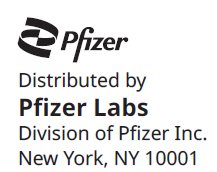
LAB-0276-42.0
Patient Information
CADUET® (CAD-oo-et) (amlodipine and atorvastatin) Tablets
Read the patient information that comes with CADUET before you start taking it, and each time you get a refill. There may be new information. This information does not replace talking with your doctor about your condition or treatment. If you have any questions about CADUET, ask your doctor or pharmacist.
What is CADUET?
CADUET is a prescription drug that combines Norvasc® (amlodipine besylate) and Lipitor® (atorvastatin calcium) in one pill.
CADUET is used in adults who need both Norvasc and Lipitor.
Norvasc is used to treat:
• High blood pressure (hypertension) and• Chest pain (angina) and• Blocked arteries of the heart (coronary artery disease)
Lipitor is used to lower the levels of "bad" cholesterol and triglycerides in your blood. It can also raise the levels of "good" cholesterol.
Lipitor is also used to lower the risk for heart attack, stroke, certain types of heart surgery, and chest pain in patients who have heart disease or risk factors for heart disease such as:
• age, smoking, high blood pressure, low levels of "good" cholesterol, heart disease in the family.
Lipitor can lower the risk for heart attack or stroke in patients with diabetes and risk factors such as:
• diabetic eye or kidney problems, smoking, or high blood pressure.
CADUET has not been studied in children.
Who should not use CADUET?
Do not use CADUET if you:
• Are pregnant or think you may be pregnant, or are planning to become pregnant. CADUET may harm your unborn baby. If you get pregnant, stop taking CADUET and call your doctor right away.• Are breastfeeding. CADUET can pass into your breast milk and may harm your baby. Do not breastfeed if you take CADUET.• Have liver problems.• Are allergic to anything in CADUET. The active ingredients are atorvastatin calcium and amlodipine besylate. See the end of this leaflet for a complete ul of ingredients.
What should I tell my doctor before taking CADUET?
Tell your doctor about all of your health conditions, including, if you have:
• heart disease• muscle aches or weakness• diabetes• thyroid problems• kidney problems• or drink more than 2 glasses of alcohol daily
Tell your doctor about all the medicines you take including prescription and nonprescription medicines, vitamins, and herbal supplements. CADUET and some other medicines can interact, causing serious side effects. Especially tell your doctor if you take medicines for:
• your immune system• infections• cholesterol• hepatitis C virus
• birth control• heart failure• HIV (AIDS)• anti-virals
You can use nitroglycerin and CADUET together. If you take nitroglycerin for chest pain (angina), do not stop taking it while taking CADUET.
Know all the medicines you take. Keep a ul of them with you to show your doctor and pharmacist.
How should I take CADUET?
• Take CADUET once a day, exactly as your doctor tells you. Do not change your dose or stop CADUET without talking to your doctor.• Take CADUET each day at any time of day, at about the same time each day. CADUET can be taken with or without food.• Do not break the tablets before taking them. Talk to your doctor if you have a problem swallowing pills.• Your doctor should start you on a low-fat diet before giving you CADUET. Stay on this low-fat diet when you take CADUET.• If you miss a dose, take it as soon as you remember. Do not take CADUET if it has been more than 12 hours since your missed dose. Just take the next dose at your regular time. Do not take 2 doses of CADUET at the same time.• If too much CADUET is taken by accident, call your doctor or poison control center, or go to the nearest emergency room.
What should I avoid while taking CADUET?
• Avoid getting pregnant. If you get pregnant, stop taking CADUET right away and call your doctor.• Do not breastfeed. CADUET can pass into your breast milk and may harm your baby.
What are possible side effects of CADUET?
CADUET can cause serious side effects. These side effects happen only to a small number of people. Your doctor can monitor you for them. These side effects usually go away if your dose is lowered or CADUET is stopped. These serious side effects include:
• Muscle problems. CADUET can cause serious muscle problems that can lead to kidney problems, including kidney failure. You have a higher chance for muscle problems if you are taking certain other medicines with CADUET.• Liver problems. Your doctor should do blood tests to check your liver before you start taking CADUET and if you have symptoms of liver problems while you take CADUET. Call your doctor right away if you have the following symptoms of liver problems:
• feel tired or weak• loss of appetite• upper belly pain• dark amber colored urine• yellowing of your skin or the whites of your eyes• Low blood pressure or dizziness• Muscle rigidity, tremor and/or abnormal muscle movement
Call your doctor right away if:
• you have muscle problems like weakness, tenderness, or pain that happen without a good reason, especially if you also have a fever or feel more tired than usual. This may be an early sign of a rare muscle problem.• muscle problems that do not go away even after your doctor has advised you to stop taking CADUET. Your doctor may do further tests to diagnose the cause of your muscle problems.• allergic reactions including swelling of the face, lips, tongue, and/or throat that may cause difficulty in breathing or swallowing which may require treatment right away• you have nausea and vomiting, stomach pain• you are passing brown or dark-colored urine• you feel more tired than usual• your skin and white of your eyes get yellow• you have allergic skin reactions• Chest pain that does not go away or gets worse. Sometimes when you start CADUET or increase your dose, chest pain can get worse or a heart attack can happen. If this happens, call your doctor or go to the emergency room right away.
Common side effects of CADUET include:
• Diarrhea• Swelling of your legs or ankles• Nausea• Upset stomach• Muscle and joint pain• Alterations in some laboratory blood tests
Additional side effects have been reported: tiredness, tendon problems, memory loss, and confusion.
Talk to your doctor or pharmacist about side effects that bother you or do not go away.
There are other side effects of CADUET. Ask your doctor or pharmacist for a complete ul.
How do I store CADUET?
• Store CADUET at room temperature, 68 to 77°F (20 to 25°C).• Do not keep medicine that is out-of-date or that you no longer need.• Keep CADUET and all medicines out of the reach of children. Keep medicines in places where children cannot get it.
General information about CADUET
Medicines are sometimes prescribed for conditions that are not mentioned in patient information leaflets. Do not use CADUET for a condition for which it was not prescribed. Do not give CADUET to other people, even if they have the same problem you have. It may harm them. This leaflet summarizes the most important information about CADUET. If you want more information, talk with your doctor. Ask your doctor or pharmacist for information about CADUET written for health professionals. You can also go to the CADUET website at www.CADUET.com.
What is high blood pressure (hypertension)?
You have high blood pressure when the force of blood against the walls of your arteries stays high. This can damage your heart and other parts of your body. Drugs that lower blood pressure lower your risk of having a stroke or heart attack.
What is angina (chest pain)?
Angina is a pain that keeps coming back when part of your heart does not get enough blood. It feels like something is pressing or squeezing your chest under the breastbone. Sometimes you can feel it in your shoulders, arms, neck, jaw, or back.
What is cholesterol?
Cholesterol is a fat-like substance made in your body. It is also found in foods. You need some cholesterol for good health, but too much is not good for you. Cholesterol can clog your blood vessels.
What is a heart attack?
A heart attack occurs when heart muscle does not get enough blood. Symptoms include chest pain, trouble breathing, nausea, and weakness. Heart muscle cells may be damaged or die. The heart cannot pump well or may stop beating.
What is a stroke?
A stroke occurs when nerve cells in the brain do not get enough blood. The cells may be damaged or die. The damaged cells may cause weakness or problems speaking or thinking.
WHAT ARE THE INGREDIENTS IN CADUET?
Active ingredients: amlodipine besylate, atorvastatin calcium
Inactive ingredients: calcium carbonate, croscarmellose sodium, microcrystalline cellulose, pregelatinized starch, polysorbate 80, hydroxypropyl cellulose, purified water, colloidal silicon dioxide (anhydrous), magnesium stearate
Film coating: Opadry® II White 85F28751 (polyvinyl alcohol, titanium dioxide, PEG 3000, and talc) or Opadry® II Blue 85F10919 (polyvinyl alcohol, titanium dioxide, PEG 3000, talc, and FD&C blue #2)
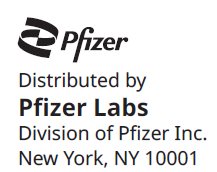
LAB-0347-13.0Revised August 2023
Package Label.principal Display Panel
PRINCIPAL DISPLAY PANEL - 5 mg/10 mg Tablet Bottle Label
Pfizer NDC 0069-2150-30
Caduet®
(amlodipine besylate/atorvastatin calcium)
Tablets
5 mg/10 mg*
30 Tablets Rx only

Package Label.principal Display Panel
PRINCIPAL DISPLAY PANEL - 5 mg/20 mg Tablet Bottle Label
Pfizer NDC 0069-2170-30
Caduet®
(amlodipine besylate/atorvastatin calcium)
Tablets
5 mg/20 mg*
30 Tablets Rx only
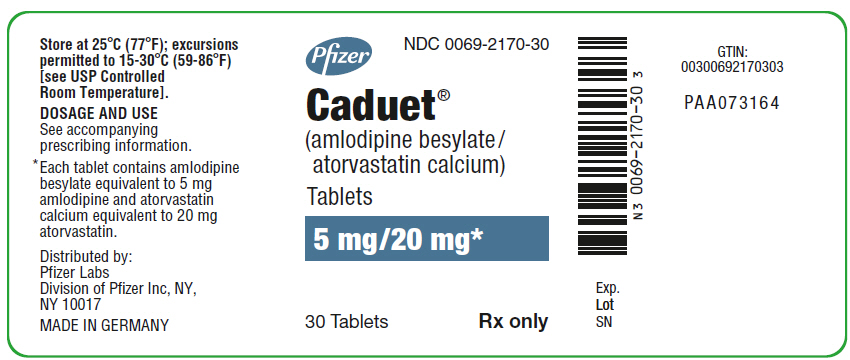
Package Label.principal Display Panel
PRINCIPAL DISPLAY PANEL - 5 mg/40 mg Tablet Bottle Label
Pfizer NDC 0069-2190-30
Caduet®
(amlodipine besylate/atorvastatin calcium)
Tablets
5 mg/40 mg*
30 Tablets Rx only
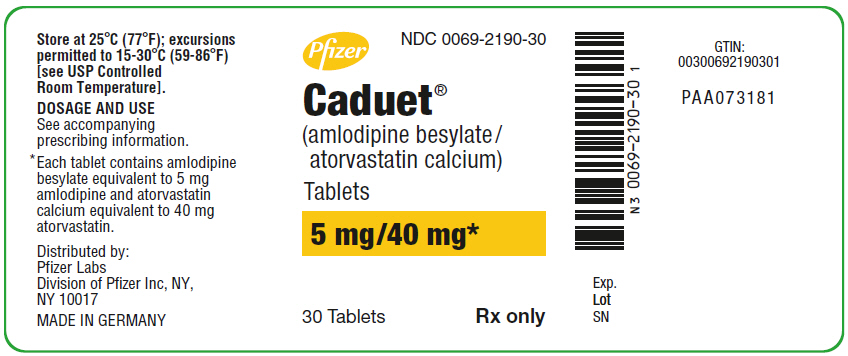
Package Label.principal Display Panel
PRINCIPAL DISPLAY PANEL - 5 mg/80 mg Tablet Bottle Label
Pfizer NDC 0069-2260-30
Caduet®
(amlodipine besylate/atorvastatin calcium)
Tablets
5 mg/80 mg*
30 Tablets Rx only
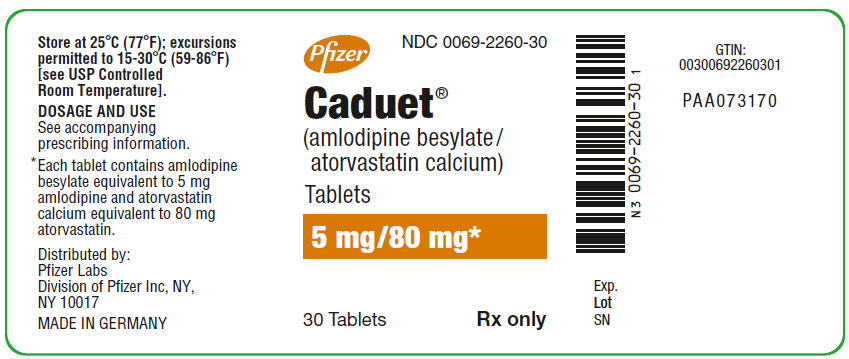
Package Label.principal Display Panel
PRINCIPAL DISPLAY PANEL - 10 mg/10 mg Tablet Bottle Label
Pfizer NDC 0069-2160-30
Caduet®
(amlodipine besylate/atorvastatin calcium)
Tablets
10 mg/10 mg*
30 Tablets Rx only
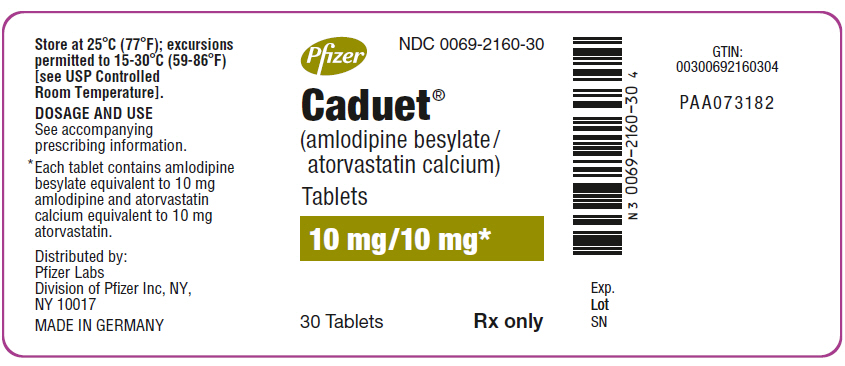
Package Label.principal Display Panel
PRINCIPAL DISPLAY PANEL - 10 mg/20 mg Tablet Bottle Label
Pfizer NDC 0069-2180-30
Caduet®
(amlodipine besylate/atorvastatin calcium)
Tablets
10 mg/20 mg*
30 Tablets Rx only
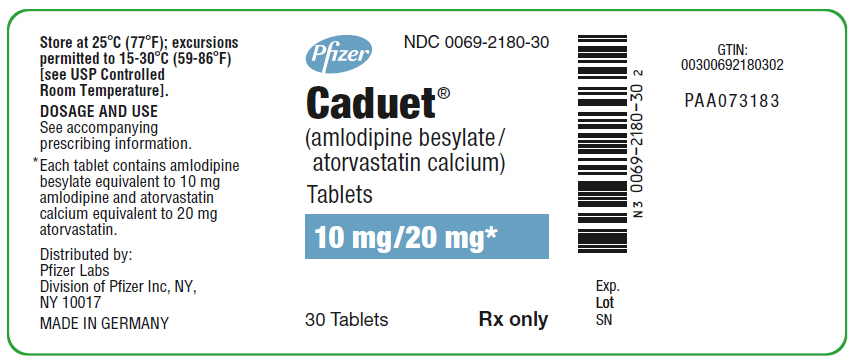
Package Label.principal Display Panel
PRINCIPAL DISPLAY PANEL - 10 mg/40 mg Tablet Bottle Label
Pfizer NDC 0069-2250-30
Caduet®
(amlodipine besylate/atorvastatin calcium)
Tablets
10 mg/40 mg*
30 Tablets Rx only

Package Label.principal Display Panel
PRINCIPAL DISPLAY PANEL - 10 mg/80 mg Tablet Bottle Label
Pfizer NDC 0069-2270-30
Caduet®
(amlodipine besylate/atorvastatin calcium)
Tablets
10 mg/80 mg*
30 Tablets Rx only
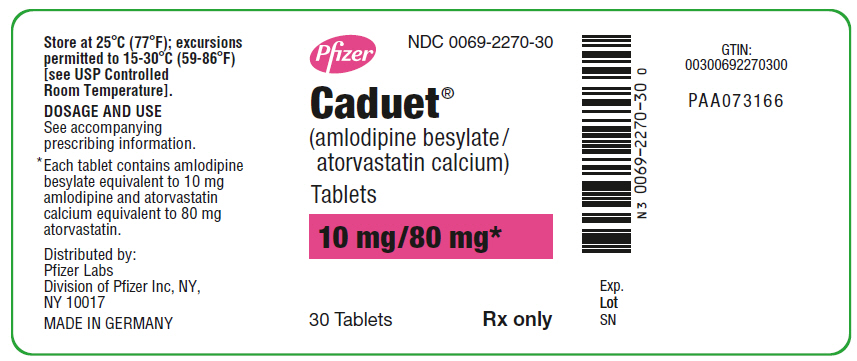
Principal Display Panel - 5 Mg/10 Mg Tablet Bottle Label - 6180-30
PfizerNDC 0069-6180-30
Caduet® (amlodipine andatorvastatin)tablets
5 mg/10 mg*
30 TabletsRx only
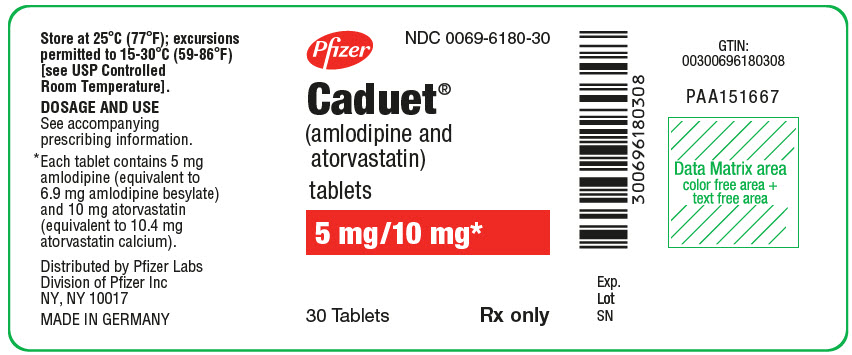
Principal Display Panel - 5 Mg/20 Mg Tablet Bottle Label - 6323-30
PfizerNDC 0069-6323-30
Caduet® (amlodipine andatorvastatin)tablets
5 mg/20 mg*
30 TabletsRx only
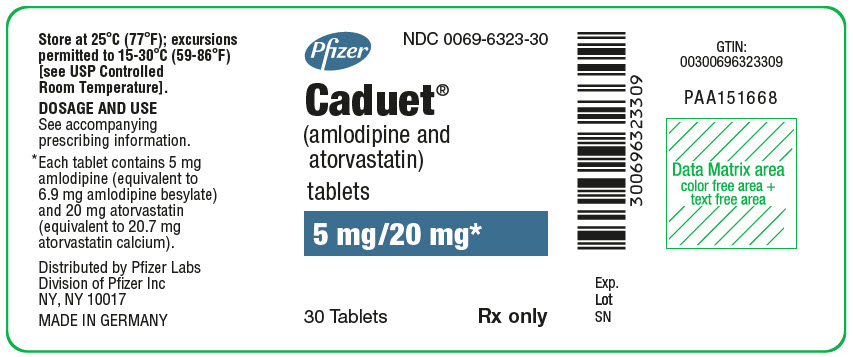
Principal Display Panel - 5 Mg/40 Mg Tablet Bottle Label - 6565-30
PfizerNDC 0069-6565-30
Caduet® (amlodipine andatorvastatin)tablets
5 mg/40 mg*
30 TabletsRx only
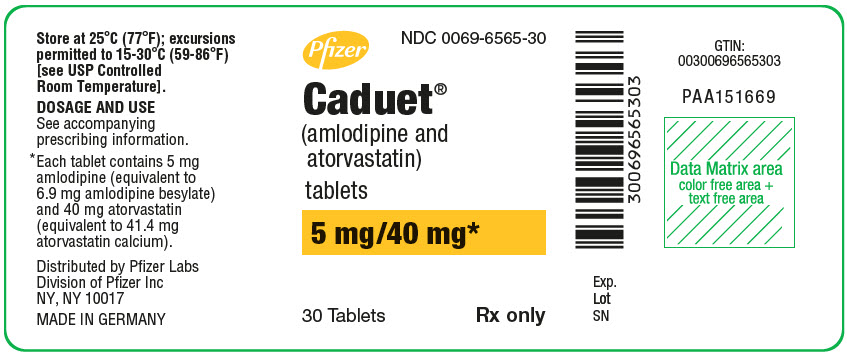
Principal Display Panel - 5 Mg/80 Mg Tablet Bottle Label - 6747-30
PfizerNDC 0069-6747-30
Caduet® (amlodipine andatorvastatin)tablets
5 mg/80 mg*
30 TabletsRx only
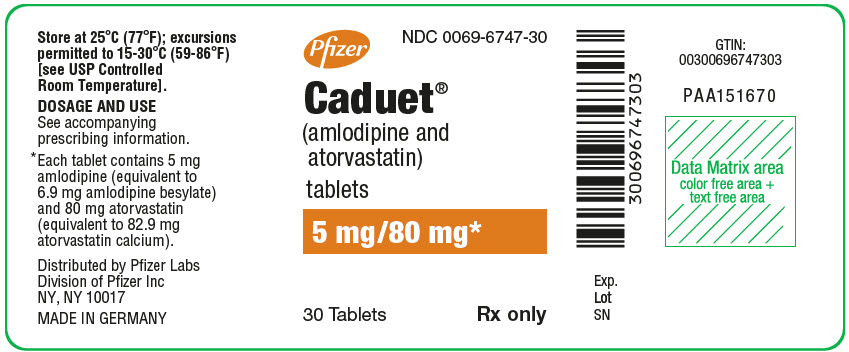
Principal Display Panel - 10 Mg/10 Mg Tablet Bottle Label - 7810-30
PfizerNDC 0069-7810-30
Caduet® (amlodipine andatorvastatin)tablets
10 mg/10 mg*
30 TabletsRx only
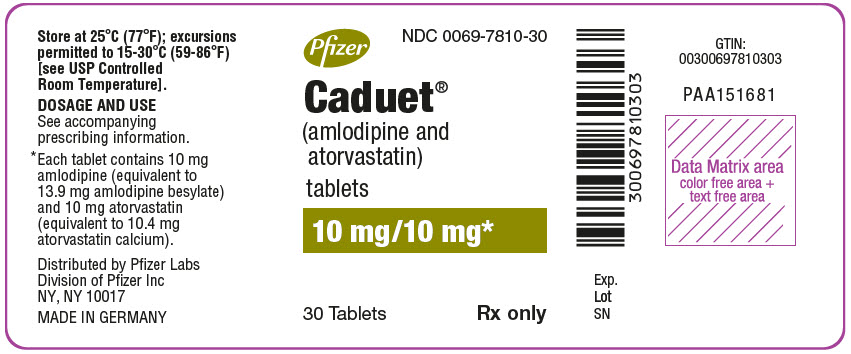
Principal Display Panel - 10 Mg/20 Mg Tablet Bottle Label - 7232-30
PfizerNDC 0069-7232-30
Caduet® (amlodipine andatorvastatin)tablets
10 mg/20 mg*
30 TabletsRx only
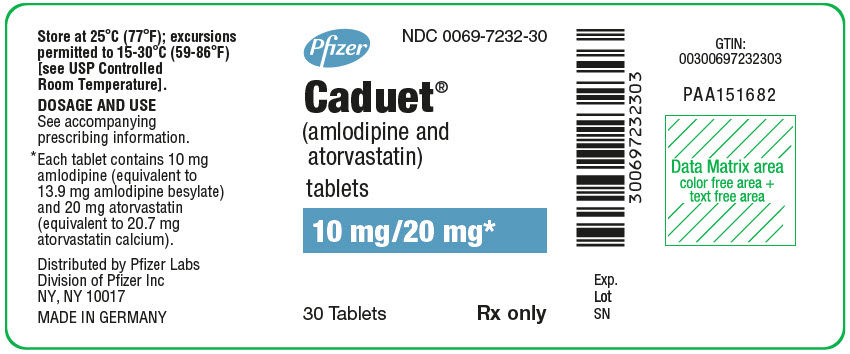
Principal Display Panel - 10 Mg/40 Mg Tablet Bottle Label - 7654-30
PfizerNDC 0069-7654-30
Caduet® (amlodipine andatorvastatin)tablets
10 mg/40 mg*
30 TabletsRx only
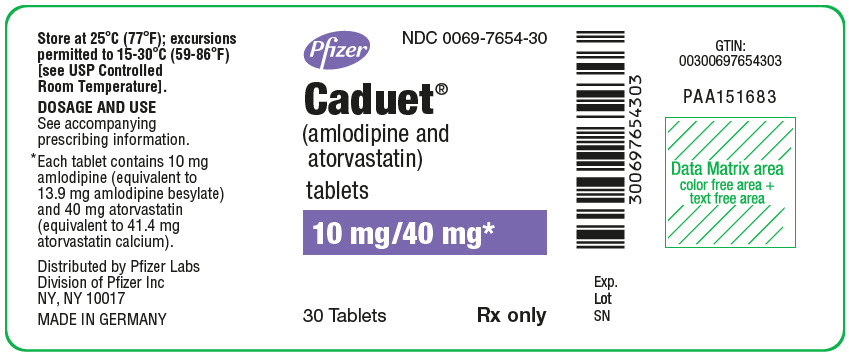
Principal Display Panel - 10 Mg/80 Mg Tablet Bottle Label - 7476-30
PfizerNDC 0069-7476-30
Caduet® (amlodipine andatorvastatin)tablets
10 mg/80 mg*
30 TabletsRx only
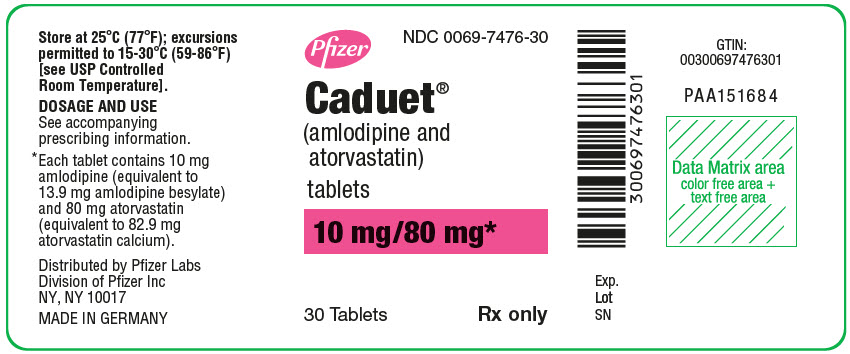
DISCLAIMER:
"This tool does not provide medical advice, and is for informational and educational purposes only, and is not a substitute for professional medical advice, treatment or diagnosis. Call your doctor to receive medical advice. If you think you may have a medical emergency, please dial 911."
"Do not rely on openFDA to make decisions regarding medical care. While we make every effort to ensure that data is accurate, you should assume all results are unvalidated. We may limit or otherwise restrict your access to the API in line with our Terms of Service."
"This product uses publicly available data from the U.S. National Library of Medicine (NLM), National Institutes of Health, Department of Health and Human Services; NLM is not responsible for the product and does not endorse or recommend this or any other product."
PillSync may earn a commission via links on our site


